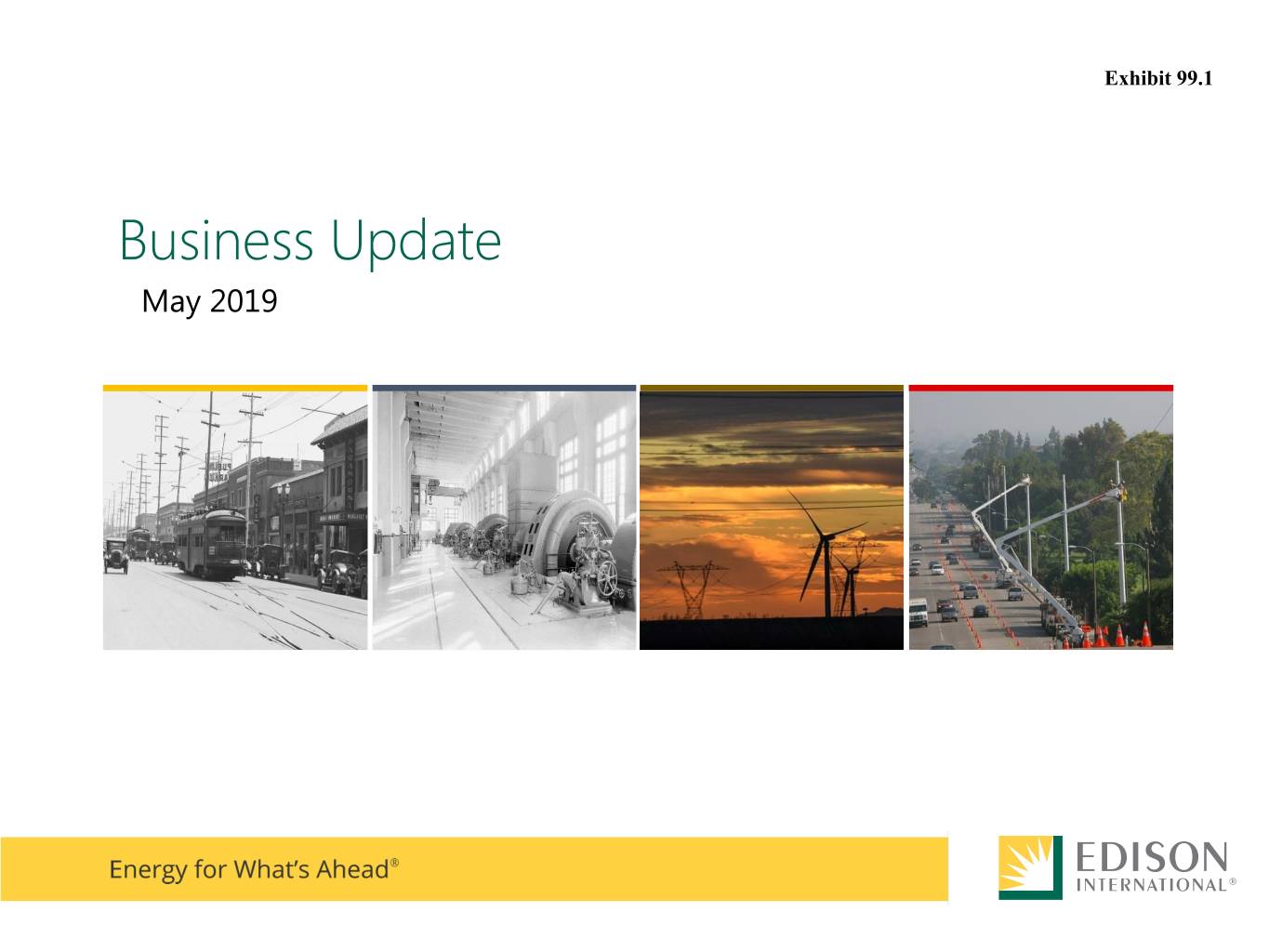
Exhibit 99.1 Business Update May 2019
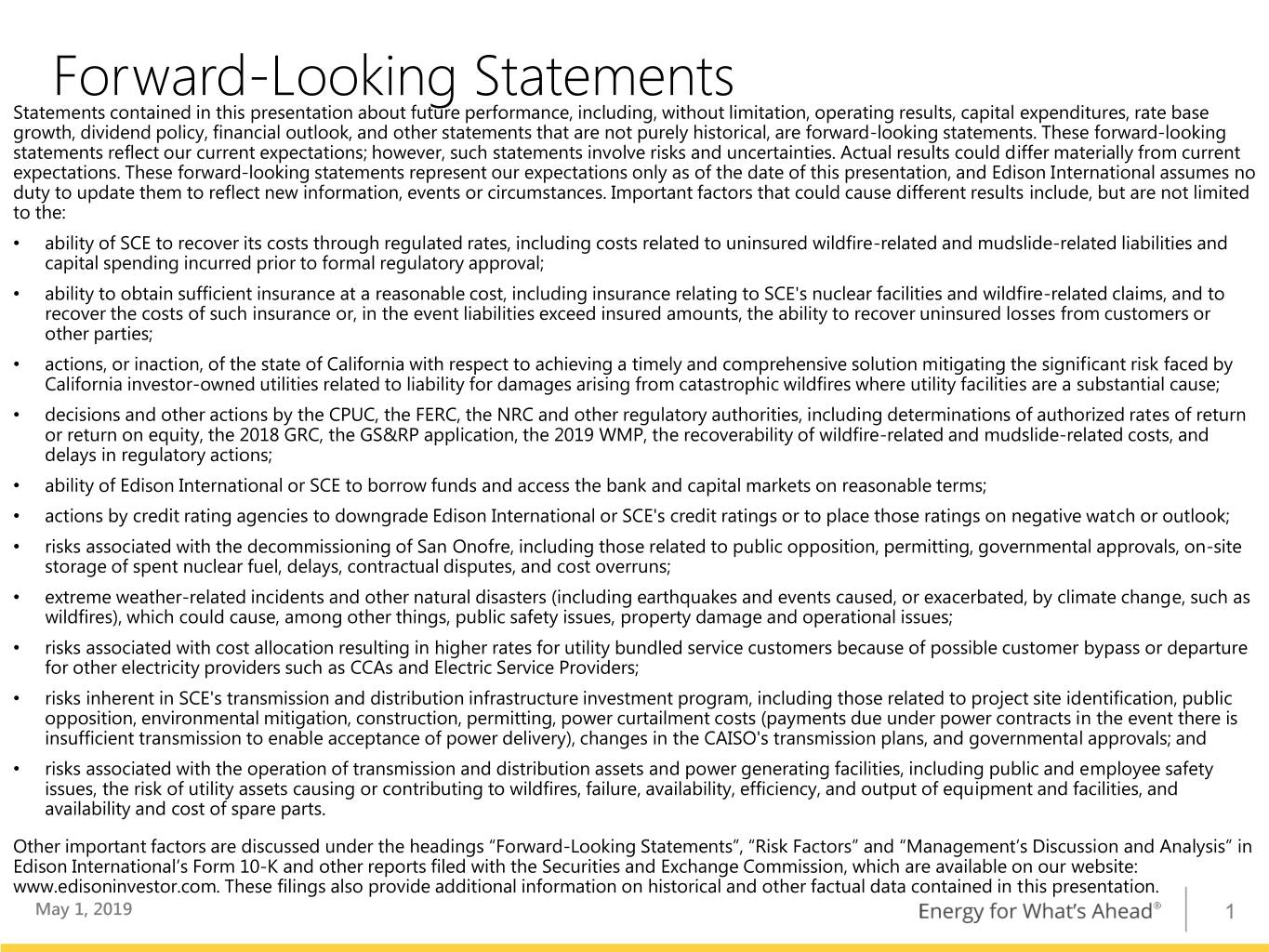
Forward-Looking Statements Statements contained in this presentation about future performance, including, without limitation, operating results, capital expenditures, rate base growth, dividend policy, financial outlook, and other statements that are not purely historical, are forward-looking statements. These forward-looking statements reflect our current expectations; however, such statements involve risks and uncertainties. Actual results could differ materially from current expectations. These forward-looking statements represent our expectations only as of the date of this presentation, and Edison International assumes no duty to update them to reflect new information, events or circumstances. Important factors that could cause different results include, but are not limited to the: • ability of SCE to recover its costs through regulated rates, including costs related to uninsured wildfire-related and mudslide-related liabilities and capital spending incurred prior to formal regulatory approval; • ability to obtain sufficient insurance at a reasonable cost, including insurance relating to SCE's nuclear facilities and wildfire-related claims, and to recover the costs of such insurance or, in the event liabilities exceed insured amounts, the ability to recover uninsured losses from customers or other parties; • actions, or inaction, of the state of California with respect to achieving a timely and comprehensive solution mitigating the significant risk faced by California investor-owned utilities related to liability for damages arising from catastrophic wildfires where utility facilities are a substantial cause; • decisions and other actions by the CPUC, the FERC, the NRC and other regulatory authorities, including determinations of authorized rates of return or return on equity, the 2018 GRC, the GS&RP application, the 2019 WMP, the recoverability of wildfire-related and mudslide-related costs, and delays in regulatory actions; • ability of Edison International or SCE to borrow funds and access the bank and capital markets on reasonable terms; • actions by credit rating agencies to downgrade Edison International or SCE's credit ratings or to place those ratings on negative watch or outlook; • risks associated with the decommissioning of San Onofre, including those related to public opposition, permitting, governmental approvals, on-site storage of spent nuclear fuel, delays, contractual disputes, and cost overruns; • extreme weather-related incidents and other natural disasters (including earthquakes and events caused, or exacerbated, by climate change, such as wildfires), which could cause, among other things, public safety issues, property damage and operational issues; • risks associated with cost allocation resulting in higher rates for utility bundled service customers because of possible customer bypass or departure for other electricity providers such as CCAs and Electric Service Providers; • risks inherent in SCE's transmission and distribution infrastructure investment program, including those related to project site identification, public opposition, environmental mitigation, construction, permitting, power curtailment costs (payments due under power contracts in the event there is insufficient transmission to enable acceptance of power delivery), changes in the CAISO's transmission plans, and governmental approvals; and • risks associated with the operation of transmission and distribution assets and power generating facilities, including public and employee safety issues, the risk of utility assets causing or contributing to wildfires, failure, availability, efficiency, and output of equipment and facilities, and availability and cost of spare parts. Other important factors are discussed under the headings “Forward-Looking Statements”, “Risk Factors” and “Management’s Discussion and Analysis” in Edison International’s Form 10-K and other reports filed with the Securities and Exchange Commission, which are available on our website: www.edisoninvestor.com. These filings also provide additional information on historical and other factual data contained in this presentation. May 1, 2019 1

Table of Contents Updated (U) or New (N) from Page March 2019 Business Update EIX Shareholder Value 3 U SCE Highlights, SCE Long-Term Growth Drivers, Regulatory Model 4-6 U California’s GHG Emissions Overview, SCE’s Clean Power and Electrification Pathway 7-8 U 2018 General Rate Case Proposed Decision 9-10 N CPUC and FERC Cost of Capital Summary 11 N Capital Expenditures and Rate Base History and Forecast 12-14 U 2019 Financial Assumptions and HoldCo Financing Plan 15-16 N,U Wildfire Mitigation/Prevention and Legislation Summary 17-18 U Key Regulatory Proceedings 19 U CPUC Cost of Capital (2013-2019) 20 U Distribution and Transmission Capital Expenditure Detail 21-23 U Operational Excellence 24 EIX Responding to Industry Change, EIX’s ESG Strategy and Edison Energy Group Summary 25-27 U Annual Dividends Per Share 28 Appendix SCE Historical Capital Expenditures 30 Capital Expenditure and Rate Base Detailed Forecast 31 U Credit Ratings Summary 32 U Power Grid of the Future, Grid Modernization 33-34 SCE Customer Demand Trends 35 SCE Bundled Revenue Requirement, System Average Rate Historical Growth 36-37 U CCA Overview, Residential Rate Reform and Other, SCE Rates and Bills Comparison 38-42 U First Quarter 2019 Earnings Summary, Results of Operations, Non-GAAP Reconciliations 43-47 N,U May 1, 2019 2

EIX Strategy Should Produce Long-Term Value Sustained Earnings and Dividend Electric-Led Clean Energy Future Growth Led by SCE SCE Rate Base Growth Drives Earnings EIX Vision • 8.0% average annual rate base • Lead transformation of the electric growth through 2020 power industry • SCE earnings should track rate base • Focus on clean energy, efficient growth over the long term electrification, grid of the future and customers’ technology choice Constructive Regulatory Structure Wires-Focused SCE Strategy • Decoupling of electricity sales • Infrastructure replacement – safety • Balancing accounts and reliability • Forward-looking ratemaking • Grid modernization – California’s low- Sustainable Dividend Growth carbon goals • Target payout ratio of 45-55% of SCE • Grid resiliency and safety earnings • Operational excellence Edison Energy Strategy • Services for large commercial and industrial customers May 1, 2019 3
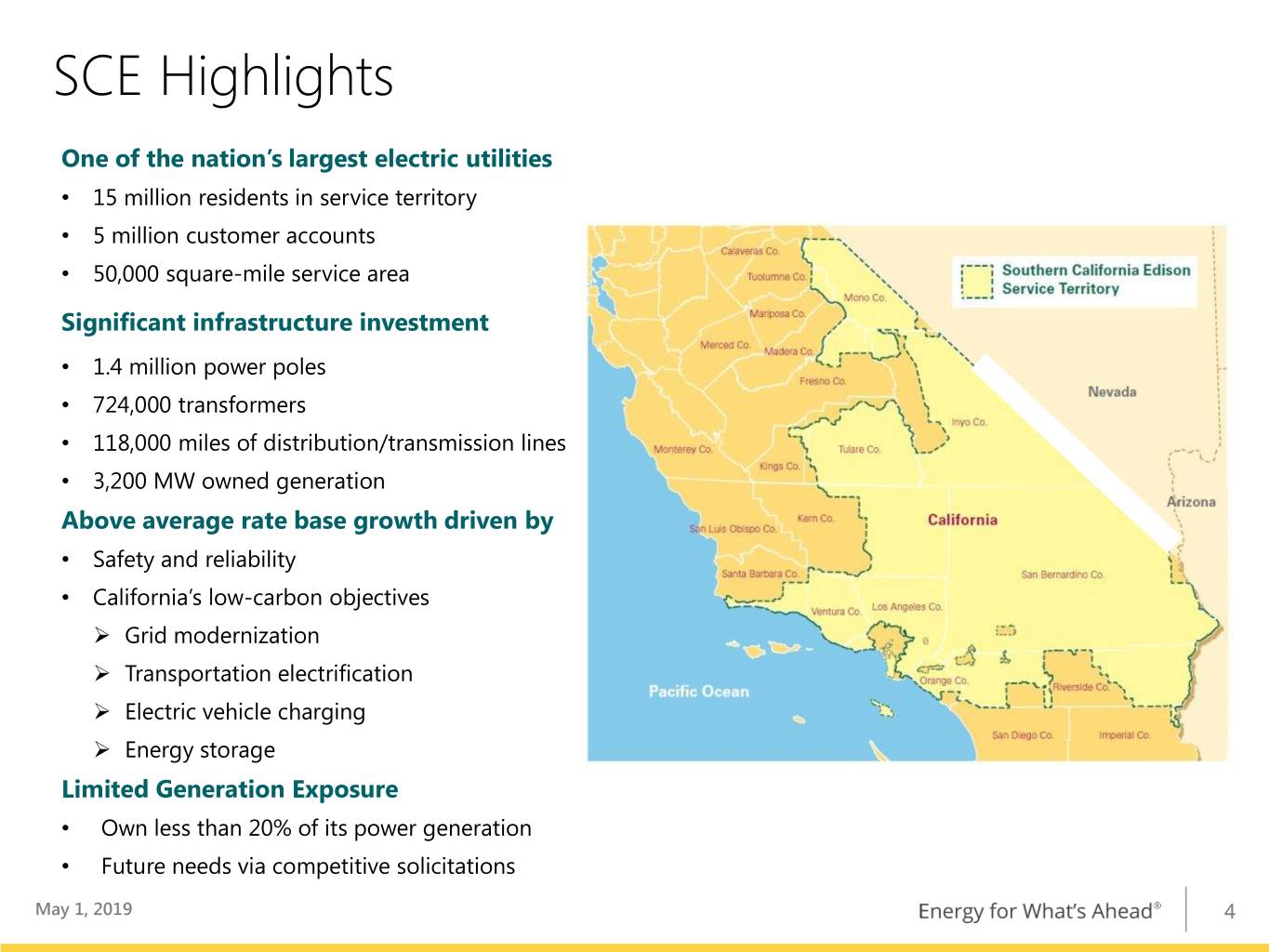
SCE Highlights One of the nation’s largest electric utilities • 15 million residents in service territory • 5 million customer accounts • 50,000 square-mile service area Significant infrastructure investment • 1.4 million power poles • 724,000 transformers • 118,000 miles of distribution/transmission lines • 3,200 MW owned generation Above average rate base growth driven by • Safety and reliability • California’s low-carbon objectives Grid modernization Transportation electrification Electric vehicle charging Energy storage Limited Generation Exposure • Own less than 20% of its power generation • Future needs via competitive solicitations May 1, 2019 4
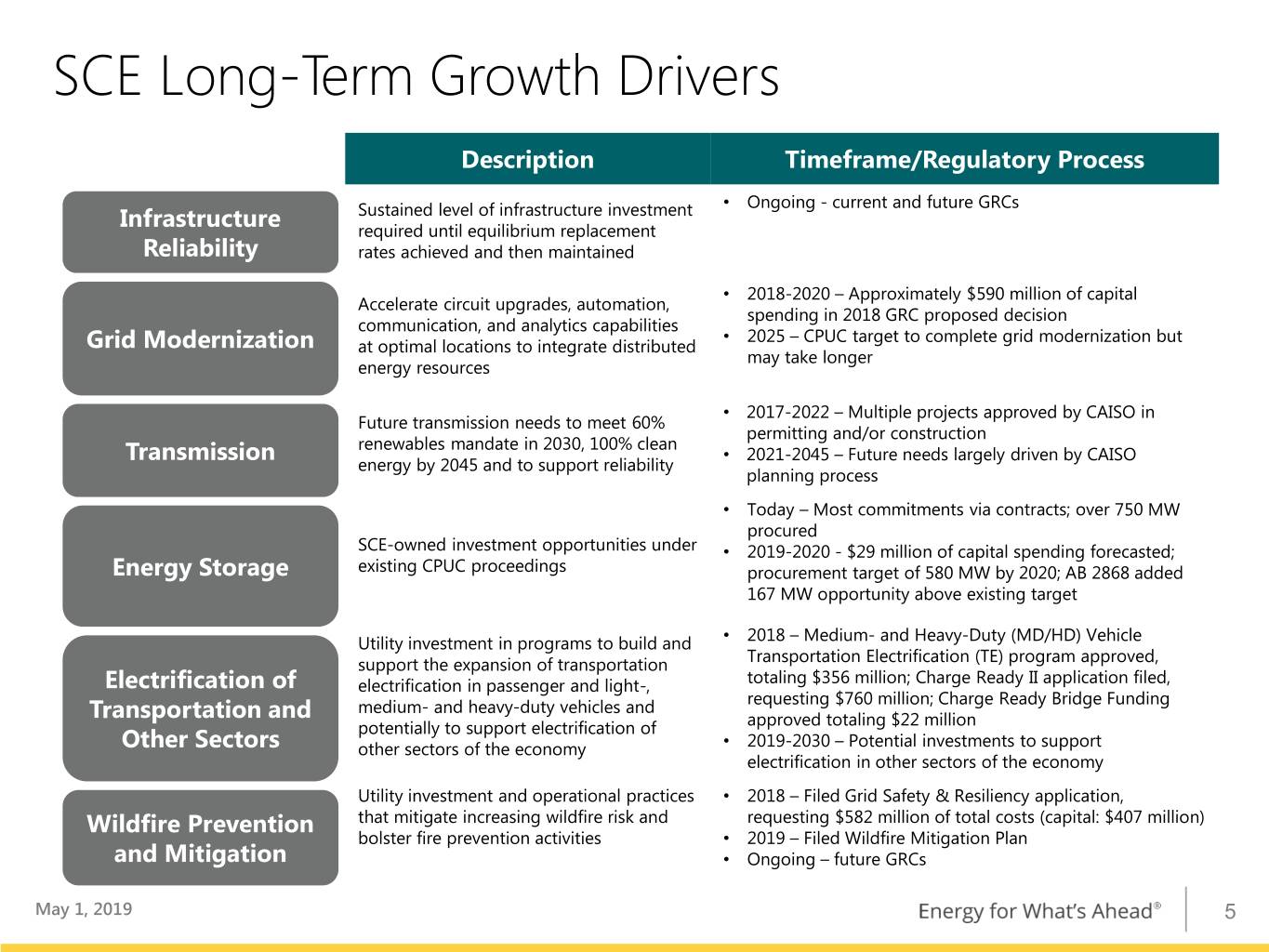
SCE Long-Term Growth Drivers Description Timeframe/Regulatory Process Sustained level of infrastructure investment • Ongoing - current and future GRCs Infrastructure required until equilibrium replacement Reliability rates achieved and then maintained • 2018-2020 – Approximately $590 million of capital Accelerate circuit upgrades, automation, spending in 2018 GRC proposed decision communication, and analytics capabilities • 2025 – CPUC target to complete grid modernization but Grid Modernization at optimal locations to integrate distributed may take longer energy resources • 2017-2022 – Multiple projects approved by CAISO in Future transmission needs to meet 60% permitting and/or construction renewables mandate in 2030, 100% clean Transmission • 2021-2045 – Future needs largely driven by CAISO energy by 2045 and to support reliability planning process • Today – Most commitments via contracts; over 750 MW procured SCE-owned investment opportunities under • 2019-2020 - $29 million of capital spending forecasted; Energy Storage existing CPUC proceedings procurement target of 580 MW by 2020; AB 2868 added 167 MW opportunity above existing target Utility investment in programs to build and • 2018 – Medium- and Heavy-Duty (MD/HD) Vehicle support the expansion of transportation Transportation Electrification (TE) program approved, Electrification of electrification in passenger and light-, totaling $356 million; Charge Ready II application filed, Transportation and medium- and heavy-duty vehicles and requesting $760 million; Charge Ready Bridge Funding potentially to support electrification of approved totaling $22 million Other Sectors other sectors of the economy • 2019-2030 – Potential investments to support electrification in other sectors of the economy Utility investment and operational practices • 2018 – Filed Grid Safety & Resiliency application, Wildfire Prevention that mitigate increasing wildfire risk and requesting $582 million of total costs (capital: $407 million) bolster fire prevention activities • 2019 – Filed Wildfire Mitigation Plan and Mitigation • Ongoing – future GRCs May 1, 2019 5
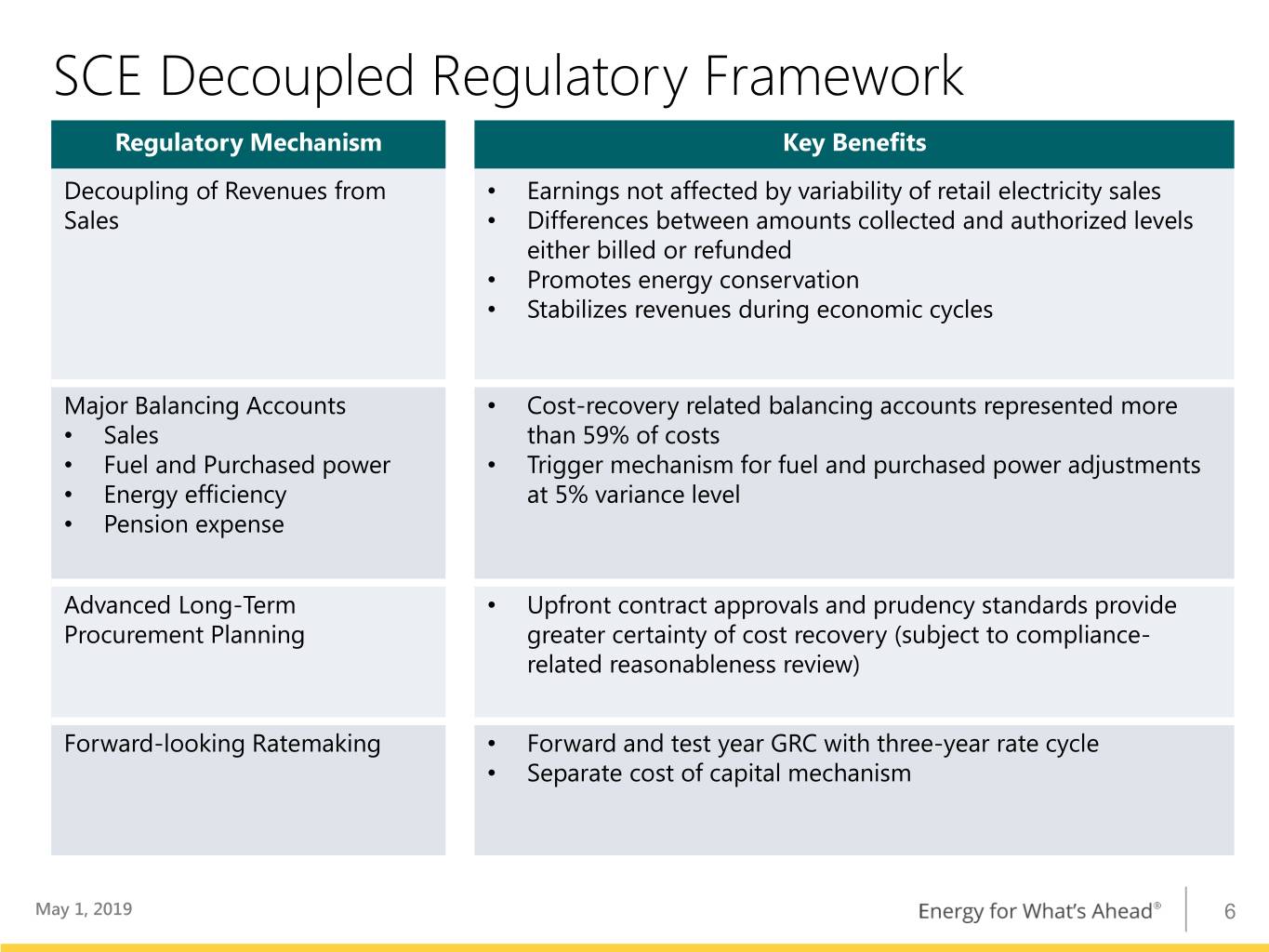
SCE Decoupled Regulatory Framework Regulatory Mechanism Key Benefits Decoupling of Revenues from • Earnings not affected by variability of retail electricity sales Sales • Differences between amounts collected and authorized levels either billed or refunded • Promotes energy conservation • Stabilizes revenues during economic cycles Major Balancing Accounts • Cost-recovery related balancing accounts represented more • Sales than 59% of costs • Fuel and Purchased power • Trigger mechanism for fuel and purchased power adjustments • Energy efficiency at 5% variance level • Pension expense Advanced Long-Term • Upfront contract approvals and prudency standards provide Procurement Planning greater certainty of cost recovery (subject to compliance- related reasonableness review) Forward-looking Ratemaking • Forward and test year GRC with three-year rate cycle • Separate cost of capital mechanism May 1, 2019 6
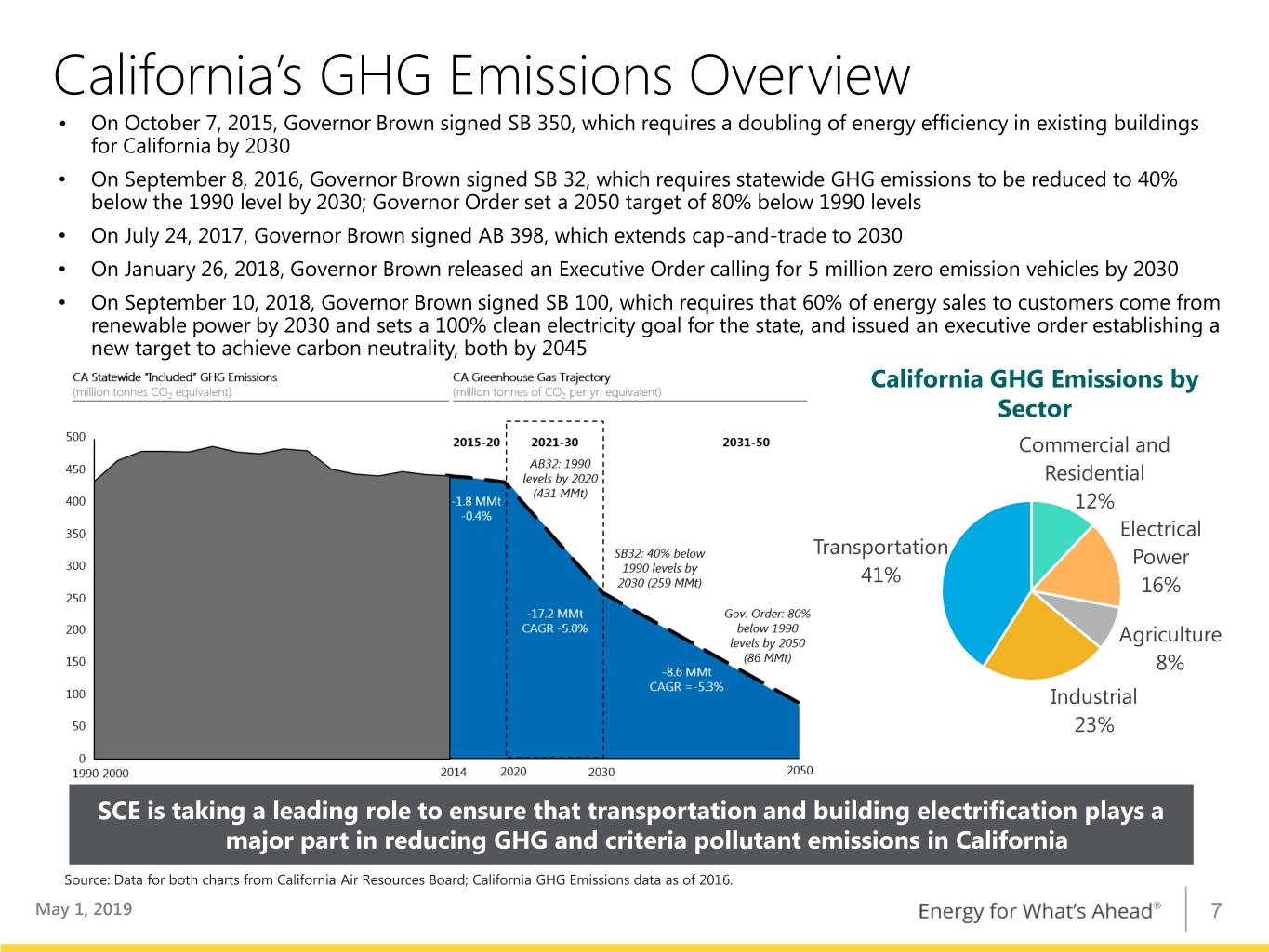
California’s GHG Emissions Overview • On October 7, 2015, Governor Brown signed SB 350, which requires a doubling of energy efficiency in existing buildings for California by 2030 • On September 8, 2016, Governor Brown signed SB 32, which requires statewide GHG emissions to be reduced to 40% below the 1990 level by 2030; Governor Order set a 2050 target of 80% below 1990 levels • On July 24, 2017, Governor Brown signed AB 398, which extends cap-and-trade to 2030 • On January 26, 2018, Governor Brown released an Executive Order calling for 5 million zero emission vehicles by 2030 • On September 10, 2018, Governor Brown signed SB 100, which requires that 60% of energy sales to customers come from renewable power by 2030 and sets a 100% clean electricity goal for the state, and issued an executive order establishing a new target to achieve carbon neutrality, both by 2045 California GHG Emissions by Sector Commercial and Residential 12% Electrical Transportation Power 41% 16% Agriculture 8% Industrial 23% SCE is taking a leading role to ensure that transportation and building electrification plays a major part in reducing GHG and criteria pollutant emissions in California Source: Data for both charts from California Air Resources Board; California GHG Emissions data as of 2016. May 1, 2019 7

SCE’s Clean Power and Electrification Pathway Electric Power Company Roles • Emissions targets met through • Accelerate electrification of the • Electrify nearly one-third of optimization of renewables transportation sector residential and commercial • Implementation of upcoming At least 7 million light-duty space and water heaters IRP filing electric vehicles on • Joint utility study by E3 shows • 80% carbon-free electricity by California roads that electrifying homes is 2030 and 100% by 2045 15% of medium-duty already cost-effective for most supported by energy storage vehicles electrified homeowners and developers • 2018 SCE renewable resources 6% of heavy-duty vehicles • Senate Bill 1477 allocates $200 portfolio = 36.3% electrified million over 4 years for pilots % Portfolio Breakdown • Joint utility study launched to • Continuation of company study transportation programs and earnings Solar 37% electrification of the I-5 incentive mechanism Wind 37% corridor Geothermal 22% Small Hydro 2% Biomass 2% May 1, 2019 8

SCE 2018 General Rate Case Proposed Decision On April 12, 2019, the CPUC issued a proposed decision which is focused on SCE’s safety and reliability investments in infrastructure replacement and grid modernization, while mitigating customer rate impacts through lower operating costs • 2018 revenue requirement proposed decision of $5.102 billion $432 million reduction from SCE’s 2018 request (7.8% lower than request) $538 million decrease from presently authorized base rates (9.6% lower than 2017 authorized) • 2018 capital spending authorization of $2.8 billion, representing 79% of SCE’s request Capital spending authorization: Traditional spending was 86% of request and Grid Modernization spending was 34% • 2018 CPUC rate base proposed decision of $22.3 billion, $674 million below SCE’s request • Opening comments are due May 2, 2019; reply comments due 5 days later Comments will include a discussion around critical principles for a durable and predictable process that leads to timely decisions, and gives SCE sufficient guidance and assurance of cost recovery for reasonable management decisions ($ billions) SCE Tax Update Testimony Proposed Decision Year 2/16/18 (Table III-1) 4/12/19 Difference ($/%) Base Revenue Requirement 2018 $5.534 $5.102 ($0.432)/(7.8%) 2019 $5.965 $5.422 ($0.543)/(9.1%) 2020 $6.468 $5.823 ($0.645)/(10.0%) CPUC Rate Base1 2018 $22.939 $22.265 ($0.674)/(2.9%) 2019 $25.181 $24.047 ($1.134)/(4.5%) 2020 $27.445 $25.858 ($1.587)/(5.8%) 1. Net of “rate-base offset” for the 2015 GRC decision May 1, 2019 9
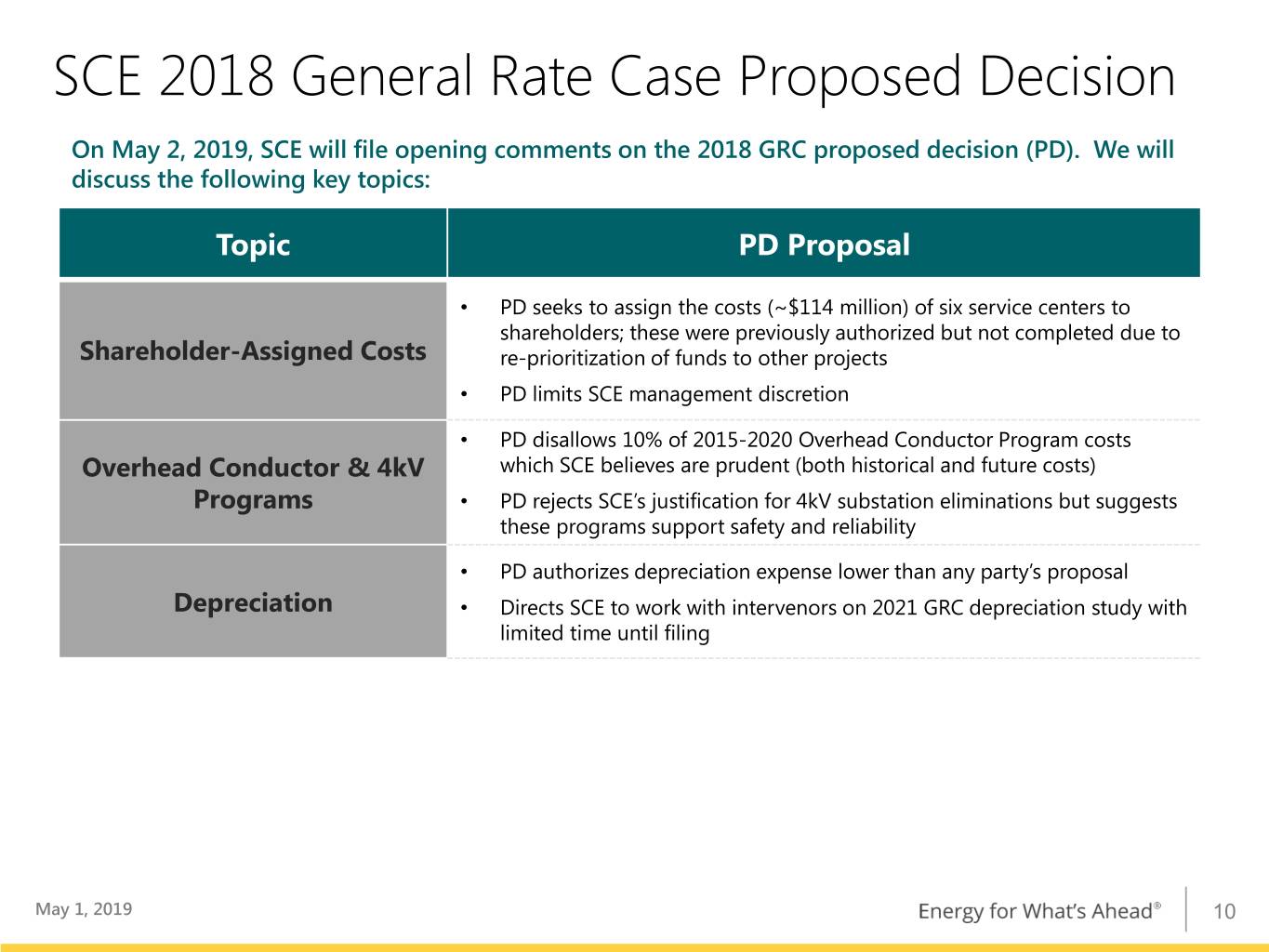
SCE 2018 General Rate Case Proposed Decision On May 2, 2019, SCE will file opening comments on the 2018 GRC proposed decision (PD). We will discuss the following key topics: Topic PD Proposal • PD seeks to assign the costs (~$114 million) of six service centers to shareholders; these were previously authorized but not completed due to Shareholder-Assigned Costs re-prioritization of funds to other projects • PD limits SCE management discretion • PD disallows 10% of 2015-2020 Overhead Conductor Program costs Overhead Conductor & 4kV which SCE believes are prudent (both historical and future costs) Programs • PD rejects SCE’s justification for 4kV substation eliminations but suggests these programs support safety and reliability • PD authorizes depreciation expense lower than any party’s proposal Depreciation • Directs SCE to work with intervenors on 2021 GRC depreciation study with limited time until filing May 1, 2019 10
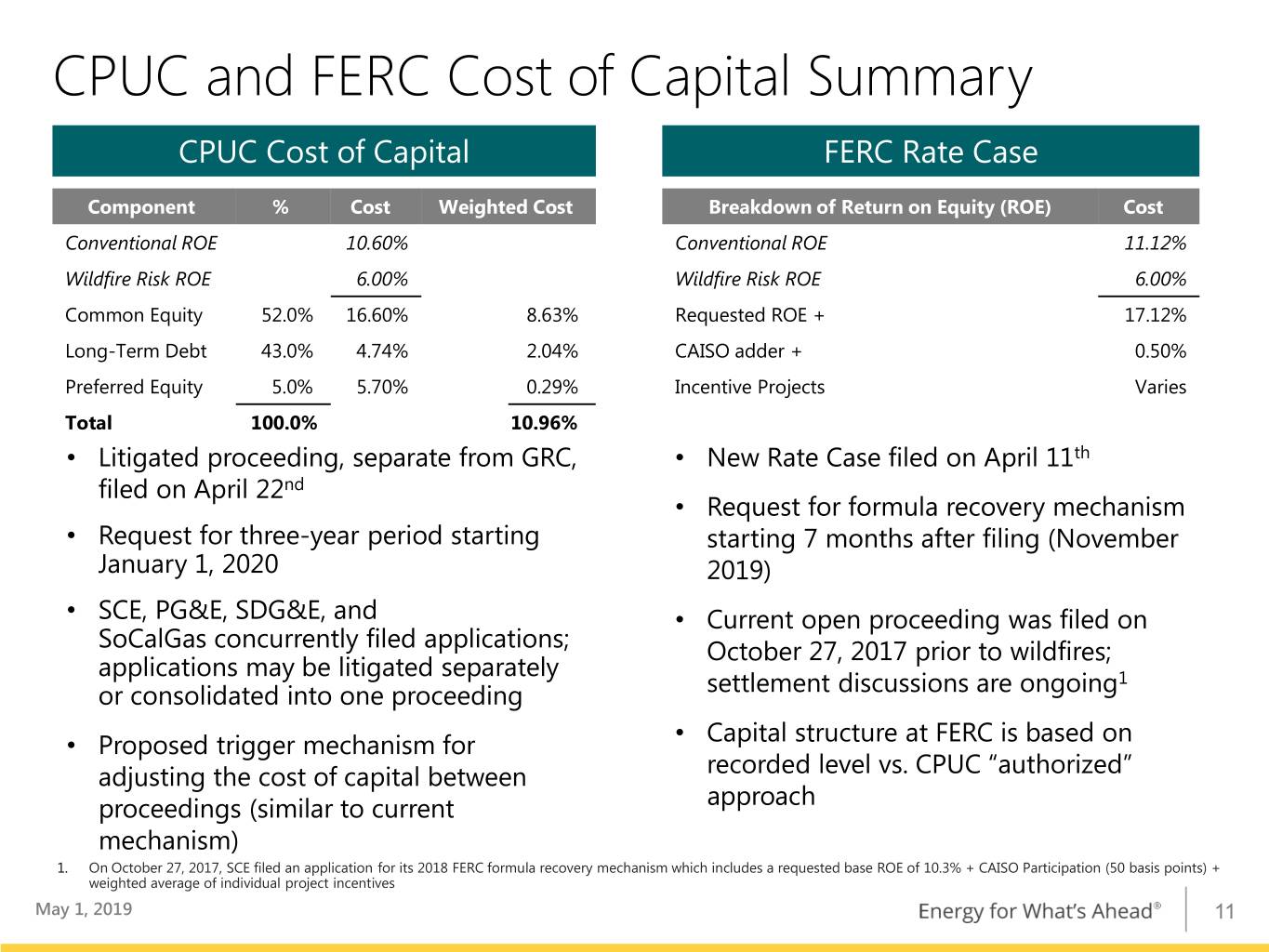
CPUC and FERC Cost of Capital Summary CPUC Cost of Capital FERC Rate Case Component % Cost Weighted Cost Breakdown of Return on Equity (ROE) Cost Conventional ROE 10.60% Conventional ROE 11.12% Wildfire Risk ROE 6.00% Wildfire Risk ROE 6.00% Common Equity 52.0% 16.60% 8.63% Requested ROE + 17.12% Long-Term Debt 43.0% 4.74% 2.04% CAISO adder + 0.50% Preferred Equity 5.0% 5.70% 0.29% Incentive Projects Varies Total 100.0% 10.96% • Litigated proceeding, separate from GRC, • New Rate Case filed on April 11th filed on April 22nd • Request for formula recovery mechanism • Request for three-year period starting starting 7 months after filing (November January 1, 2020 2019) • SCE, PG&E, SDG&E, and • Current open proceeding was filed on SoCalGas concurrently filed applications; October 27, 2017 prior to wildfires; applications may be litigated separately 1 or consolidated into one proceeding settlement discussions are ongoing • Proposed trigger mechanism for • Capital structure at FERC is based on adjusting the cost of capital between recorded level vs. CPUC “authorized” proceedings (similar to current approach mechanism) 1. On October 27, 2017, SCE filed an application for its 2018 FERC formula recovery mechanism which includes a requested base ROE of 10.3% + CAISO Participation (50 basis points) + weighted average of individual project incentives May 1, 2019 11
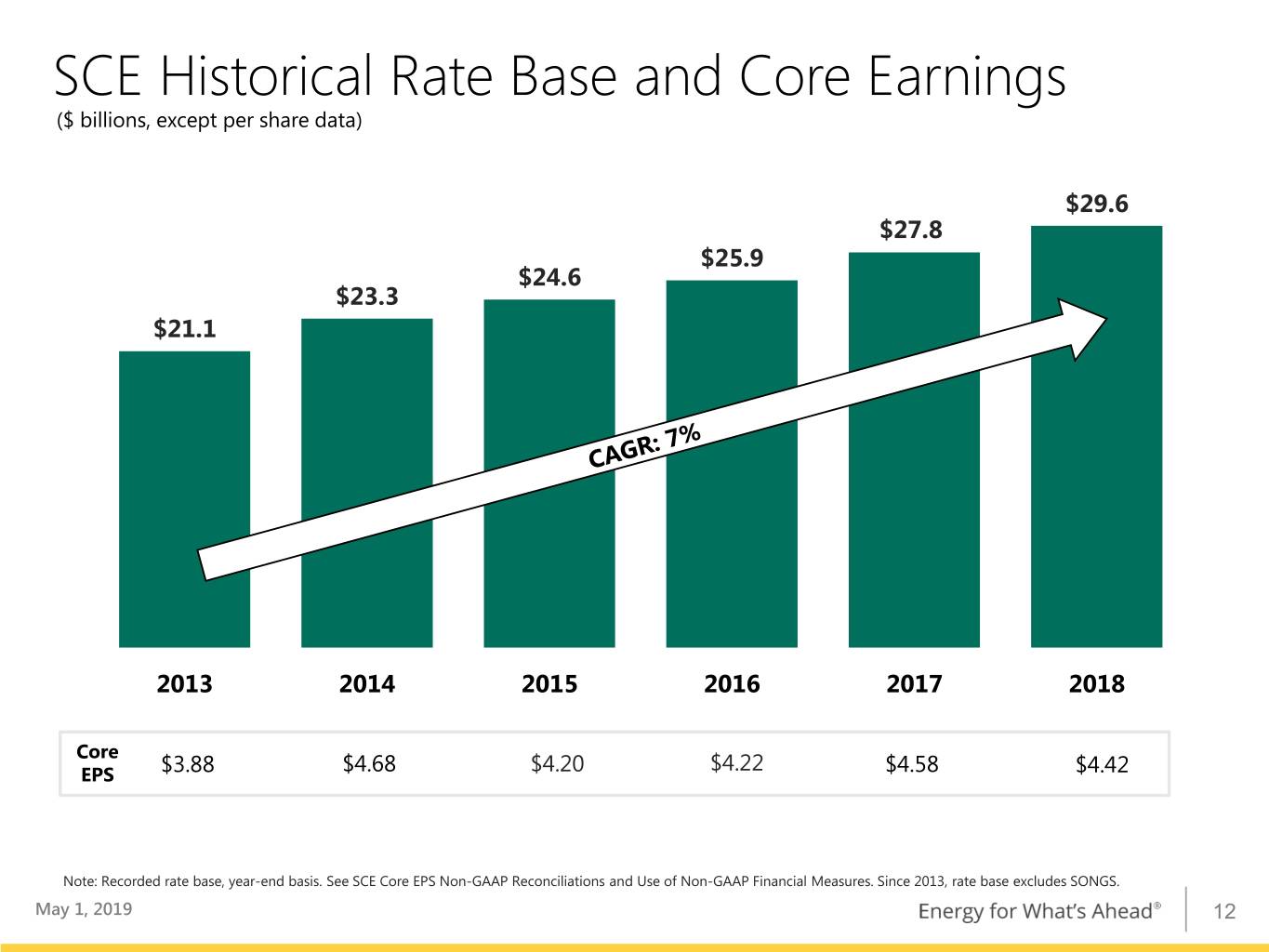
SCE Historical Rate Base and Core Earnings ($ billions, except per share data) $29.6 $27.8 $25.9 $24.6 $23.3 $21.1 2013 2014 2015 2016 2017 2018 Core $4.22 EPS $3.88 $4.68 $4.20 $4.58 $4.42 Note: Recorded rate base, year-end basis. See SCE Core EPS Non-GAAP Reconciliations and Use of Non-GAAP Financial Measures. Since 2013, rate base excludes SONGS. May 1, 2019 12

SCE Capital Expenditure Forecast ($ billions) Distribution1,2 Wildfire mitigation-related spend Long Term Growth Drivers Transmission Wildfire mitigation-related spend range Generation Transportation Electrification • Recently approved $356 million ($242 million of capital $4.6 spending) medium- and heavy-duty vehicle $4.5 $4.4 $4.4 transportation electrification program (included in forecast) • Requested $760 million ($561 million of capital spending) Charge Ready 2 application which focuses on charging infrastructure for light-duty vehicles (excluded from forecast) Wildfire Mitigation-Related Spend • Grid Safety and Resiliency Program (GS&RP): $582 million request ($407 million of capital spending) – focused on investment and operational practices that address increasing wildfire risk and bolster fire prevention and suppression activities • Wildfire Mitigation Plan (WMP) filed February 2019 and SCE expects to file its 2020 WMP by early 2020 2018 (Actual) 2019 2020 • CPUC has authorized tracking of costs related to the Prior Forecast $4.4 $4.5 $4.7 GS&RP and WMP through memorandum accounts • 2019 includes approximately $350 million of wildfire Delta ‒ ‒ ($0.1)-($0.3) mitigation-related spend, 2020 includes range of $500 to $700 million 1. Includes 2018 – 2020 capital expenditures of $846 - $1,046 million for Wildfire Mitigation-Related Spend 2. 2018-2020 total capital spend targets to GRC proposed decision over the same period Note: 2019 spending at budget levels. See Capital Expenditure/Rate Base Detailed Forecast for further information. May 1, 2019 13

SCE Rate Base Forecast – GRC Proposed Decision ($ billions) $33.1 $30.7 $28.4 2018 2019 2020 (PD) (PD) (PD) Prior Forecast $29.1 $31.8 $34.7 Delta ($0.7) ($1.1) ($1.6) Note: Weighted-average year basis; based on 2018 GRC proposed decision, subject to change. FERC based on latest forecast and current tax law, “rate-base offset” for the 2015 GRC decision excluded because of write off of regulatory asset related to 2012-2014 incremental tax repairs. Figures do not include wildfire mitigation-related dollars. May 1, 2019 14
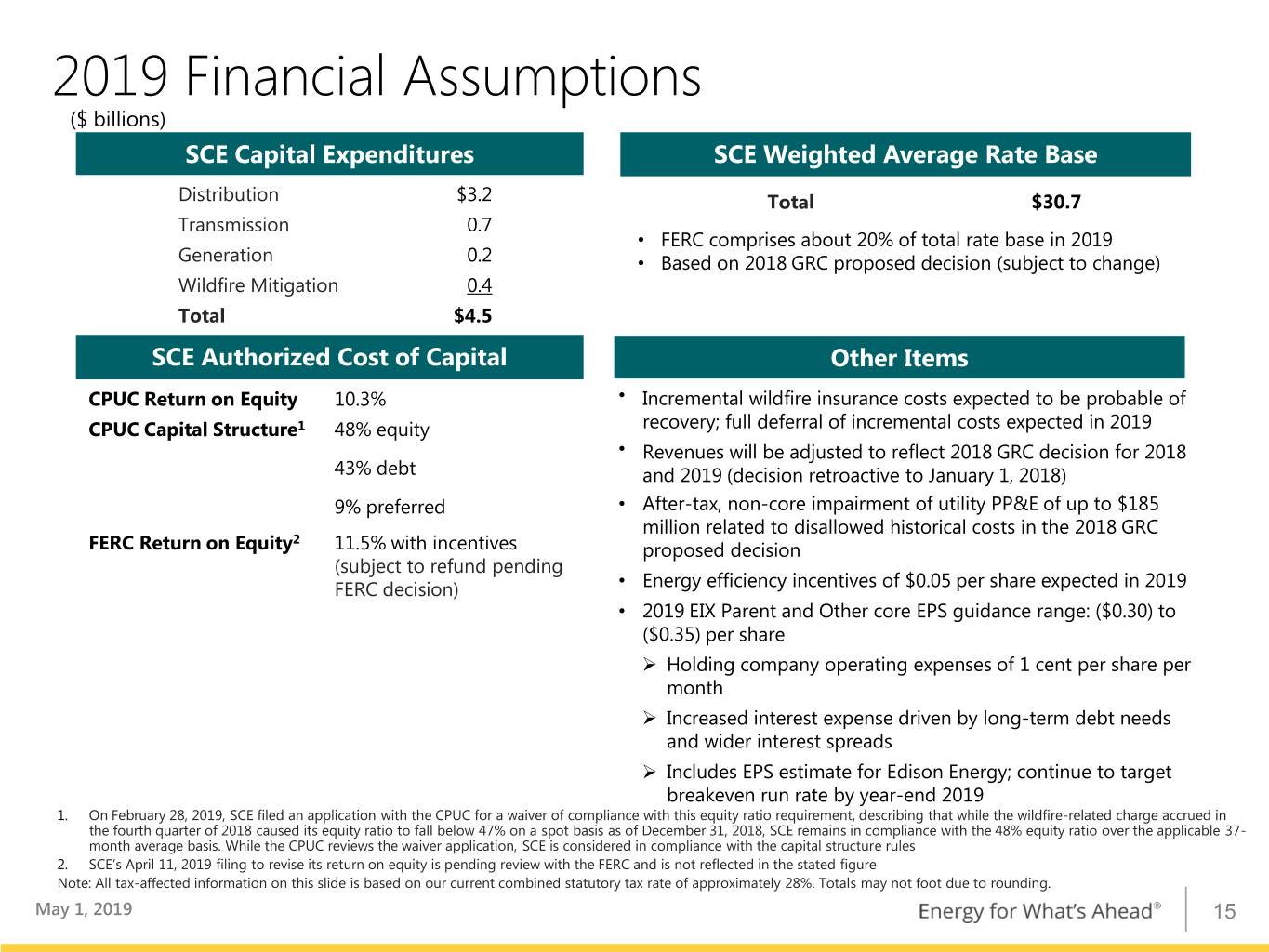
2019 Financial Assumptions ($ billions) SCE Capital Expenditures SCE Weighted Average Rate Base Distribution $3.2 Total $30.7 Transmission 0.7 • FERC comprises about 20% of total rate base in 2019 Generation 0.2 • Based on 2018 GRC proposed decision (subject to change) Wildfire Mitigation 0.4 Total $4.5 SCE Authorized Cost of Capital Other Items CPUC Return on Equity 10.3% • Incremental wildfire insurance costs expected to be probable of CPUC Capital Structure1 48% equity recovery; full deferral of incremental costs expected in 2019 • Revenues will be adjusted to reflect 2018 GRC decision for 2018 43% debt and 2019 (decision retroactive to January 1, 2018) 9% preferred • After-tax, non-core impairment of utility PP&E of up to $185 million related to disallowed historical costs in the 2018 GRC 2 FERC Return on Equity 11.5% with incentives proposed decision (subject to refund pending FERC decision) • Energy efficiency incentives of $0.05 per share expected in 2019 • 2019 EIX Parent and Other core EPS guidance range: ($0.30) to ($0.35) per share Holding company operating expenses of 1 cent per share per month Increased interest expense driven by long-term debt needs and wider interest spreads Includes EPS estimate for Edison Energy; continue to target breakeven run rate by year-end 2019 1. On February 28, 2019, SCE filed an application with the CPUC for a waiver of compliance with this equity ratio requirement, describing that while the wildfire-related charge accrued in the fourth quarter of 2018 caused its equity ratio to fall below 47% on a spot basis as of December 31, 2018, SCE remains in compliance with the 48% equity ratio over the applicable 37- month average basis. While the CPUC reviews the waiver application, SCE is considered in compliance with the capital structure rules 2. SCE’s April 11, 2019 filing to revise its return on equity is pending review with the FERC and is not reflected in the stated figure Note: All tax-affected information on this slide is based on our current combined statutory tax rate of approximately 28%. Totals may not foot due to rounding. May 1, 2019 15
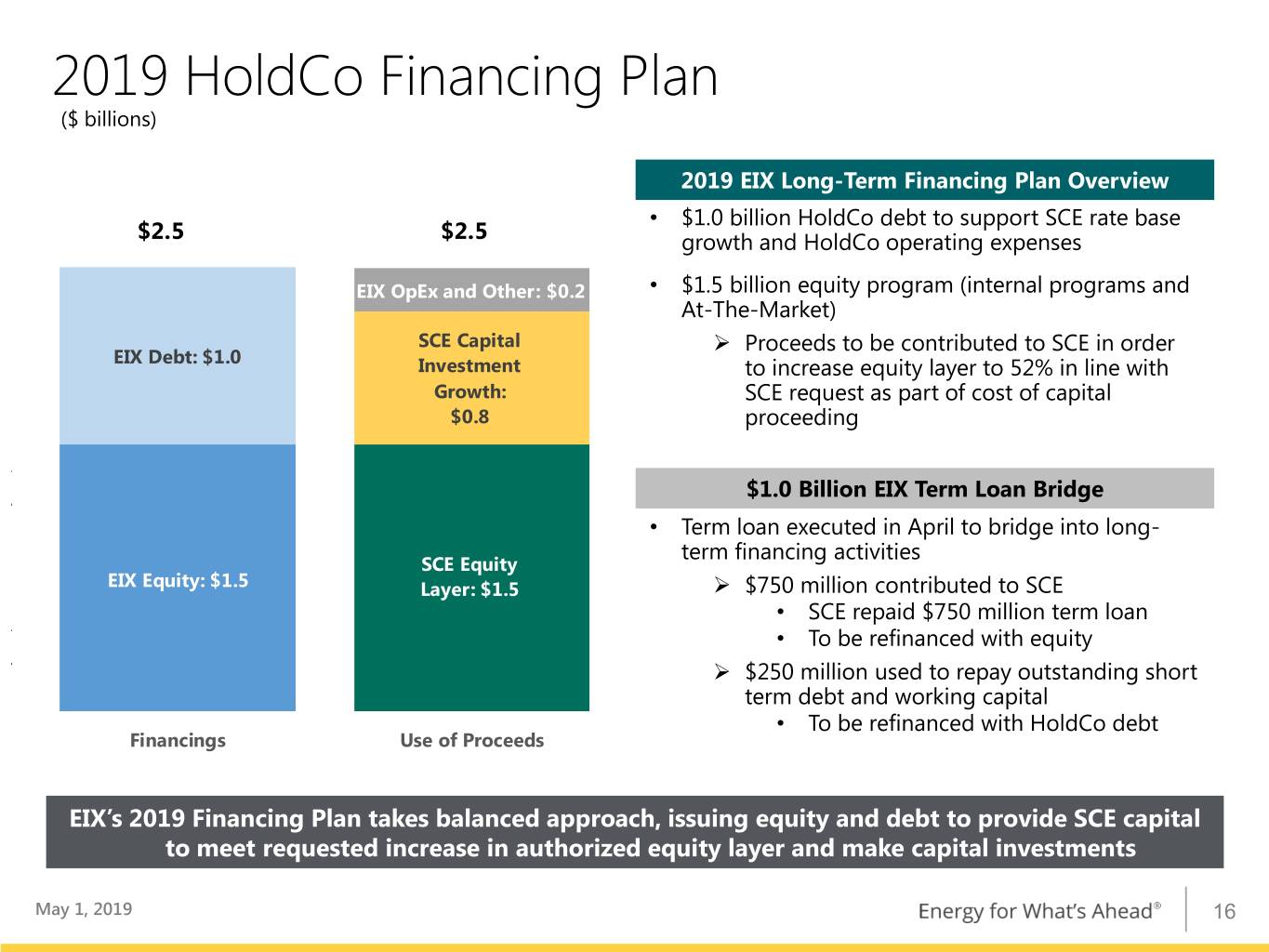
2019 HoldCo Financing Plan ($ billions) 2019 EIX Long-Term Financing Plan Overview • $1.0 billion HoldCo debt to support SCE rate base $2.5 $2.5 growth and HoldCo operating expenses EIX OpEx and Other: $0.2 • $1.5 billion equity program (internal programs and At-The-Market) SCE Capital Proceeds to be contributed to SCE in order EIX Debt: $1.0 Investment to increase equity layer to 52% in line with Growth: SCE request as part of cost of capital $0.8 proceeding $1.0 Billion EIX Term Loan Bridge • Term loan executed in April to bridge into long- term financing activities SCE Equity EIX Equity: $1.5 Layer: $1.5 $750 million contributed to SCE • SCE repaid $750 million term loan • To be refinanced with equity $250 million used to repay outstanding short term debt and working capital • To be refinanced with HoldCo debt Financings Use of Proceeds EIX’s 2019 Financing Plan takes balanced approach, issuing equity and debt to provide SCE capital to meet requested increase in authorized equity layer and make capital investments May 1, 2019 16

Wildfire Mitigation and Prevention Summary • SCE’s comprehensive risk mitigation program focuses on three key areas: Grid hardening: Significant investment to prevent ignitions including covered conductor, non- expulsion fuses, and remote-controlled automatic reclosers Increased situational awareness capabilities: High-definition cameras to support more expedient fire suppression, weather stations, and advanced analytics to prioritize mitigation efforts Enhanced operational practices: Enhanced vegetation management, enhanced overhead inspections, targeted use of Public Power Safety Shutoffs, and increased use of data analytics • Filed annual compliance plan (Wildfire Mitigation Plan) detailing the near- and longer-term actions that SCE is taking to significantly reduce the risk of fire ignitions and increase emergency response and grid resiliency against future impacts of climate change • SCE’s programs (both O&M and capital) are expected to be recovered through different avenues: Capital amounts approved in the 2018 GRC subject to management discretion Grid Safety and Resiliency Program application: $582 million of total costs ($407 million of capital) SB 901 memorandum account which will reviewed for approval during the 2021 General Rate Case proceeding SCE plans to spend approximately $350 million in 2019 and $500-$700 million in 2020 with continued investments beyond our forecast period May 1, 2019 17

Wildfire Legislation Update Summary of Senate Bill 901 Key Components Wildfire Mitigation • Requires annual detailed wildfire mitigation plans with objectives, preventive strategies, costs, metrics Plans and specific details regarding de-energization protocols, vegetation management and inspections Filed February 6, 2019; requires CPUC approval of plan within three months unless CPUC extends deadline SCE is advocating that if compliant with its plan, SCE be deemed prudent for purposes of cost recovery • Authorizes the establishment of a memorandum account to track costs until the IOU’s next GRC Forest • Enhanced forest management practices including hazardous fuels reduction, expedited removal of Management dead/dying trees and chaparral, access to lands for thinning, technical assistance for permitting Commission on • Newly created commission, appointed by Governor and Legislators, charged with providing Catastrophic recommendations for changes to law that will ensure equitable distribution of catastrophic wildfire Wildfire Cost and costs Recovery Options to include socialization of catastrophic wildfire costs in an equitable manner and/or establishment of a fund to assist in the payment of catastrophic wildfire costs Report due July 1, 2019 Wildfire Cost • Provides guidance and added flexibility to the CPUC on evaluating the reasonableness of costs and Recovery expenses by providing a list of factors that the CPUC may consider including extreme weather, climate- related impacts Securitization • Opportunity for IOUs to securitize just and reasonable wildfire-related costs for wildfires from January 1, 2019 or those that exceed the Liability Cap/Stress Test from 2017 wildfires Liability Cap/Stress • CPUC to ensure that 2017 wildfire amounts disallowed do not exceed amounts which the utility can Test pay without harming ratepayers or materially impacting its ability to provide adequate and safe service • CPUC proceeding ongoing to develop methodology Governor targeting additional legislation by mid-July, building on SB 901 and his Strike Force report which establishes a comprehensive roadmap to address critical issues relating to wildfire, climate change and California’s energy sector May 1, 2019 18
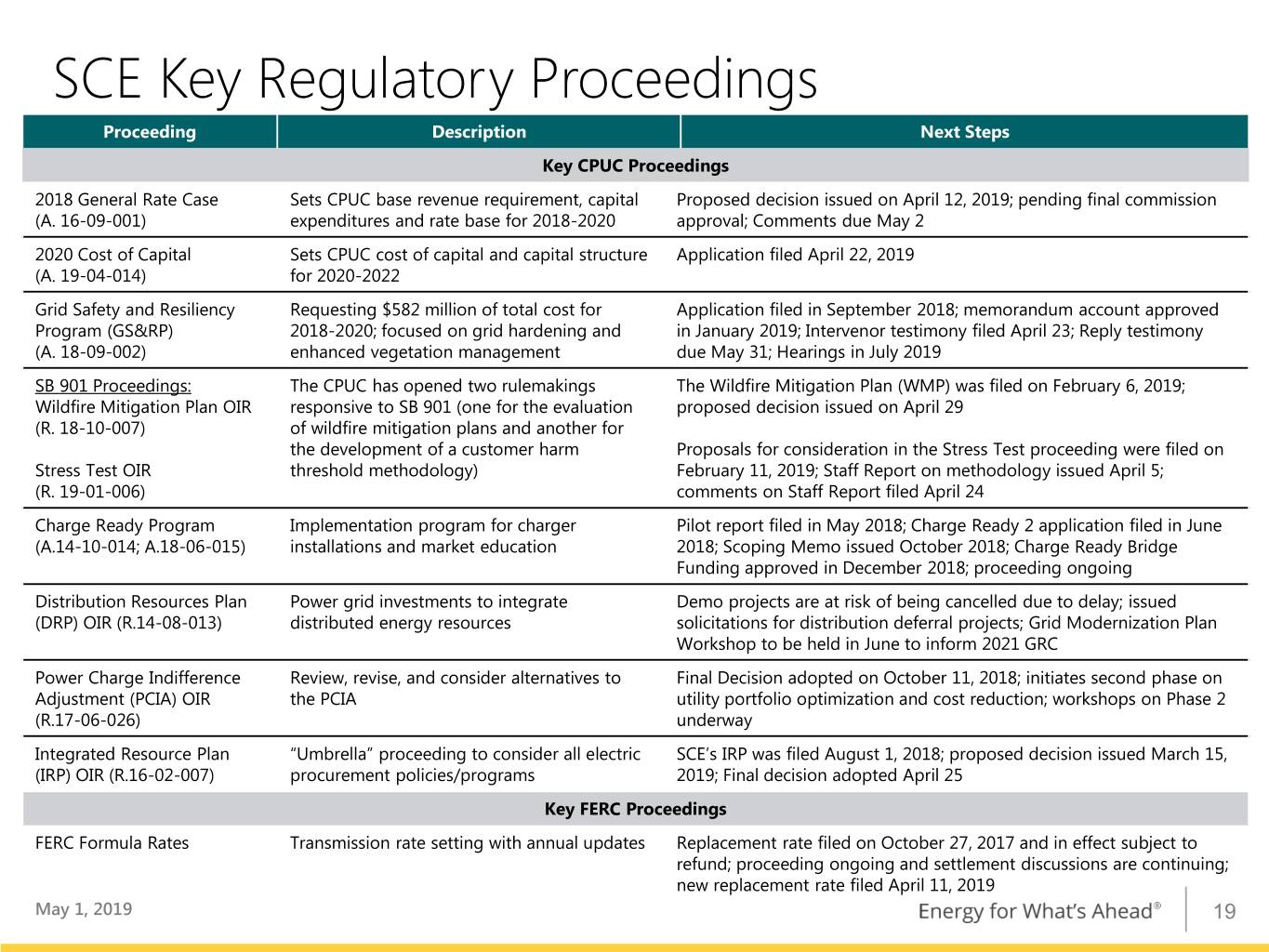
SCE Key Regulatory Proceedings Proceeding Description Next Steps Key CPUC Proceedings 2018 General Rate Case Sets CPUC base revenue requirement, capital Proposed decision issued on April 12, 2019; pending final commission (A. 16-09-001) expenditures and rate base for 2018-2020 approval; Comments due May 2 2020 Cost of Capital Sets CPUC cost of capital and capital structure Application filed April 22, 2019 (A. 19-04-014) for 2020-2022 Grid Safety and Resiliency Requesting $582 million of total cost for Application filed in September 2018; memorandum account approved Program (GS&RP) 2018-2020; focused on grid hardening and in January 2019; Intervenor testimony filed April 23; Reply testimony (A. 18-09-002) enhanced vegetation management due May 31; Hearings in July 2019 SB 901 Proceedings: The CPUC has opened two rulemakings The Wildfire Mitigation Plan (WMP) was filed on February 6, 2019; Wildfire Mitigation Plan OIR responsive to SB 901 (one for the evaluation proposed decision issued on April 29 (R. 18-10-007) of wildfire mitigation plans and another for the development of a customer harm Proposals for consideration in the Stress Test proceeding were filed on Stress Test OIR threshold methodology) February 11, 2019; Staff Report on methodology issued April 5; (R. 19-01-006) comments on Staff Report filed April 24 Charge Ready Program Implementation program for charger Pilot report filed in May 2018; Charge Ready 2 application filed in June (A.14-10-014; A.18-06-015) installations and market education 2018; Scoping Memo issued October 2018; Charge Ready Bridge Funding approved in December 2018; proceeding ongoing Distribution Resources Plan Power grid investments to integrate Demo projects are at risk of being cancelled due to delay; issued (DRP) OIR (R.14-08-013) distributed energy resources solicitations for distribution deferral projects; Grid Modernization Plan Workshop to be held in June to inform 2021 GRC Power Charge Indifference Review, revise, and consider alternatives to Final Decision adopted on October 11, 2018; initiates second phase on Adjustment (PCIA) OIR the PCIA utility portfolio optimization and cost reduction; workshops on Phase 2 (R.17-06-026) underway Integrated Resource Plan “Umbrella” proceeding to consider all electric SCE’s IRP was filed August 1, 2018; proposed decision issued March 15, (IRP) OIR (R.16-02-007) procurement policies/programs 2019; Final decision adopted April 25 Key FERC Proceedings FERC Formula Rates Transmission rate setting with annual updates Replacement rate filed on October 27, 2017 and in effect subject to refund; proceeding ongoing and settlement discussions are continuing; new replacement rate filed April 11, 2019 May 1, 2019 19
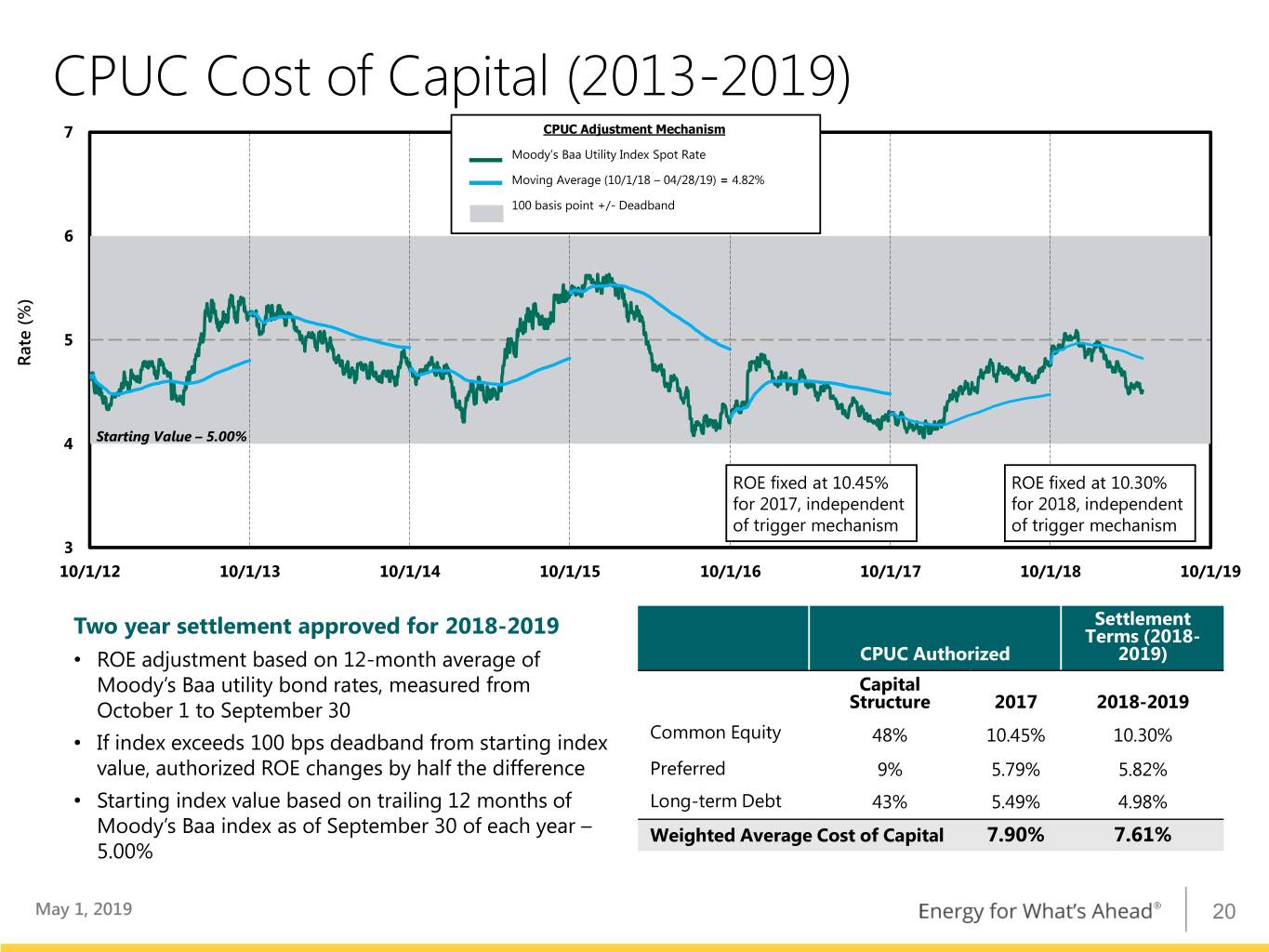
CPUC Cost of Capital (2013-2019) 7 CPUC Adjustment Mechanism Moody’s Baa Utility Index Spot Rate Moving Average (10/1/18 – 04/28/19) = 4.82% 100 basis point +/- Deadband 6 5 Rate Rate (%) 4 Starting Value – 5.00% ROE fixed at 10.45% ROE fixed at 10.30% for 2017, independent for 2018, independent of trigger mechanism of trigger mechanism 3 10/1/12 10/1/13 10/1/14 10/1/15 10/1/16 10/1/17 10/1/18 10/1/19 Settlement Two year settlement approved for 2018-2019 Terms (2018- • ROE adjustment based on 12-month average of CPUC Authorized 2019) Moody’s Baa utility bond rates, measured from Capital October 1 to September 30 Structure 2017 2018-2019 • If index exceeds 100 bps deadband from starting index Common Equity 48% 10.45% 10.30% value, authorized ROE changes by half the difference Preferred 9% 5.79% 5.82% • Starting index value based on trailing 12 months of Long-term Debt 43% 5.49% 4.98% Moody’s Baa index as of September 30 of each year – Weighted Average Cost of Capital 7.90% 7.61% 5.00% May 1, 2019 20

SCE Transportation Electrification (TE) Proposals • Proposals build on SCE’s Clean Power and Electrification Pathway which is an integrated approach to reduce GHG emissions and air pollution by taking action in three California economic sectors: electricity, transportation and buildings • These programs accelerate electrification of the transportation sector, including placing at least 7 million light-duty passenger vehicles on the roads and supporting a transition to zero-emission trucks and transit Additional studies launched to increase adoption such as electrification of the I-5 corridor Medium- and Heavy-Duty (MD/HD) Vehicle Charge Ready Bridge Funding and II Transportation Electrification Programs $356 million Total Cost1 (in nominal dollars); approved Charge Ready “Bridge” Funding - $22 million Total Cost May 2018 (in 2014 dollars); approved December 2018 • 5-year program • Additional approved capital spend of $12 million; O&M of $10 million; bridge funding must be subtracted from • Approved capital spend of $242 million; O&M of $115 any authorized Charge Ready 2 funding million • Included in capital spend and rate base forecasts • Included in capital spend and rate base forecasts • SCE to install 1,000 chargers Charge Ready I Charge Ready II – $760 million Total Cost1 (in 2018 dollars); filed June 2018 Charge Ready I - $22 million Total Cost1 (in 2014 dollars); • 4-year program, providing up to 48,000 chargers approved January 2016 • $561 million in capital spend; O&M of $199 million • Approved capital spend of $12 million; O&M of $10 million • Not included in capital spend or rate base forecasts • Supports 1,280 chargers • Included in capital spend and rate base forecasts 1. Total Cost includes both O&M and capital spend May 1, 2019 21
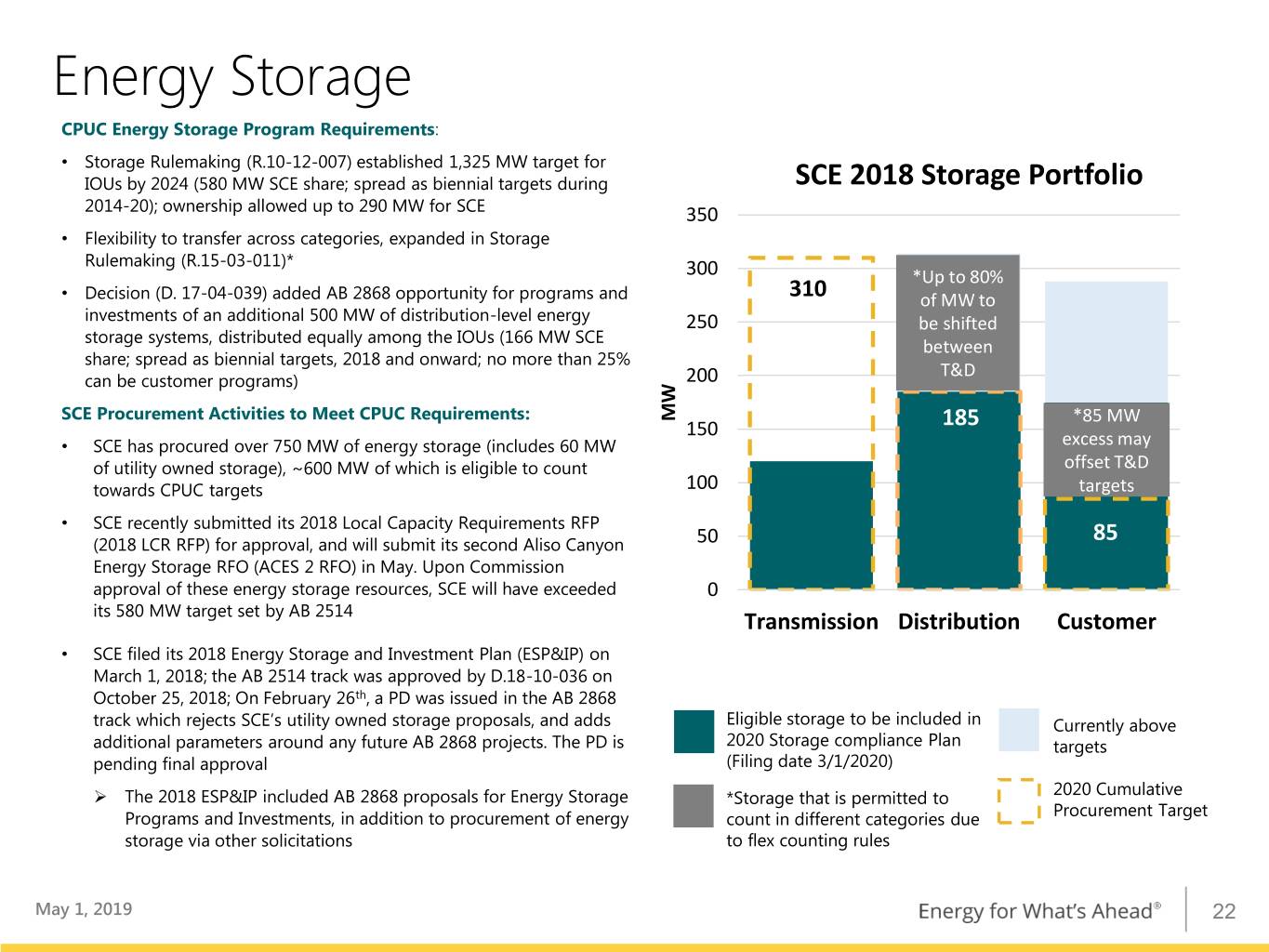
Energy Storage CPUC Energy Storage Program Requirements: • Storage Rulemaking (R.10-12-007) established 1,325 MW target for IOUs by 2024 (580 MW SCE share; spread as biennial targets during SCE 2018 Storage Portfolio 2014-20); ownership allowed up to 290 MW for SCE 350 • Flexibility to transfer across categories, expanded in Storage Rulemaking (R.15-03-011)* 300 *Up to 80% • Decision (D. 17-04-039) added AB 2868 opportunity for programs and 310 of MW to investments of an additional 500 MW of distribution-level energy 250 be shifted storage systems, distributed equally among the IOUs (166 MW SCE between share; spread as biennial targets, 2018 and onward; no more than 25% T&D can be customer programs) 200 SCE Procurement Activities to Meet CPUC Requirements: MW *85 MW 150 185 • SCE has procured over 750 MW of energy storage (includes 60 MW excess may of utility owned storage), ~600 MW of which is eligible to count offset T&D towards CPUC targets 100 targets • SCE recently submitted its 2018 Local Capacity Requirements RFP (2018 LCR RFP) for approval, and will submit its second Aliso Canyon 50 85 Energy Storage RFO (ACES 2 RFO) in May. Upon Commission approval of these energy storage resources, SCE will have exceeded 0 its 580 MW target set by AB 2514 Transmission Distribution Customer • SCE filed its 2018 Energy Storage and Investment Plan (ESP&IP) on March 1, 2018; the AB 2514 track was approved by D.18-10-036 on October 25, 2018; On February 26th, a PD was issued in the AB 2868 track which rejects SCE’s utility owned storage proposals, and adds Eligible storage to be included in Currently above additional parameters around any future AB 2868 projects. The PD is 2020 Storage compliance Plan targets pending final approval (Filing date 3/1/2020) 2020 Cumulative The 2018 ESP&IP included AB 2868 proposals for Energy Storage *Storage that is permitted to Procurement Target Programs and Investments, in addition to procurement of energy count in different categories due storage via other solicitations to flex counting rules May 1, 2019 22

SCE Large Transmission Projects Summary of Large Transmission Projects Remaining Investment Estimated In-Service Project Name Total Cost5 (as of March 31, 2019) Date West of Devers1,2 $848 million $545 million 2021 Mesa Substation1 $646 million $367 million 2022 Alberhill System3 $486 million $447 million — 3 Riverside Transmission Reliability4 $441 million $431 million 2023 Eldorado-Lugo-Mohave Upgrade $257 million $196 million 2021 FERC Cost of Capital 11.5% ROE in 20196 (subject to refund): • ROE = Requested Base of 10.3% + CAISO Participation + weighted average of individual project incentives Application for 2018 and 2019 FERC Formula recovery mechanism filed on October 27, 2017 and April 11, 2019, respectively Requested 50 bp CAISO adder; approved, but application for rehearing requested by CPUC ROE and 2018 Transmission Revenue Requirement is accepted and suspended pending settlement discussions 1. CPUC approved 2. Morongo Transmission holds an option to invest up to $400 million, or half of the estimated cost of the transmission facilities only, at the in-service date. If the option is exercised, SCE’s rate base would be offset by that amount 3. In August 2018, the CPUC approved the revised alternate decision which left the proceeding open and directed SCE to supplement the existing record with additional analysis as it relates to the Project need and alternatives. Potential revisions to the Project have not been reflected in the total cost of the Project or estimated in service date 4. Riverside Transmission Reliability Project total cost is currently estimated to be $441 million, however costs could increase depending on the final route alternative selected 5. Total Costs are nominal direct expenditures, subject to CPUC and FERC cost recovery approval. SCE regularly evaluates the cost and schedule based on permitting processes, given that SCE continues to see delays in securing project approvals 6. SCE’s April 11, 2019 filing to revise its return on equity is pending review with the FERC and is not reflected in the stated figure May 1, 2019 23
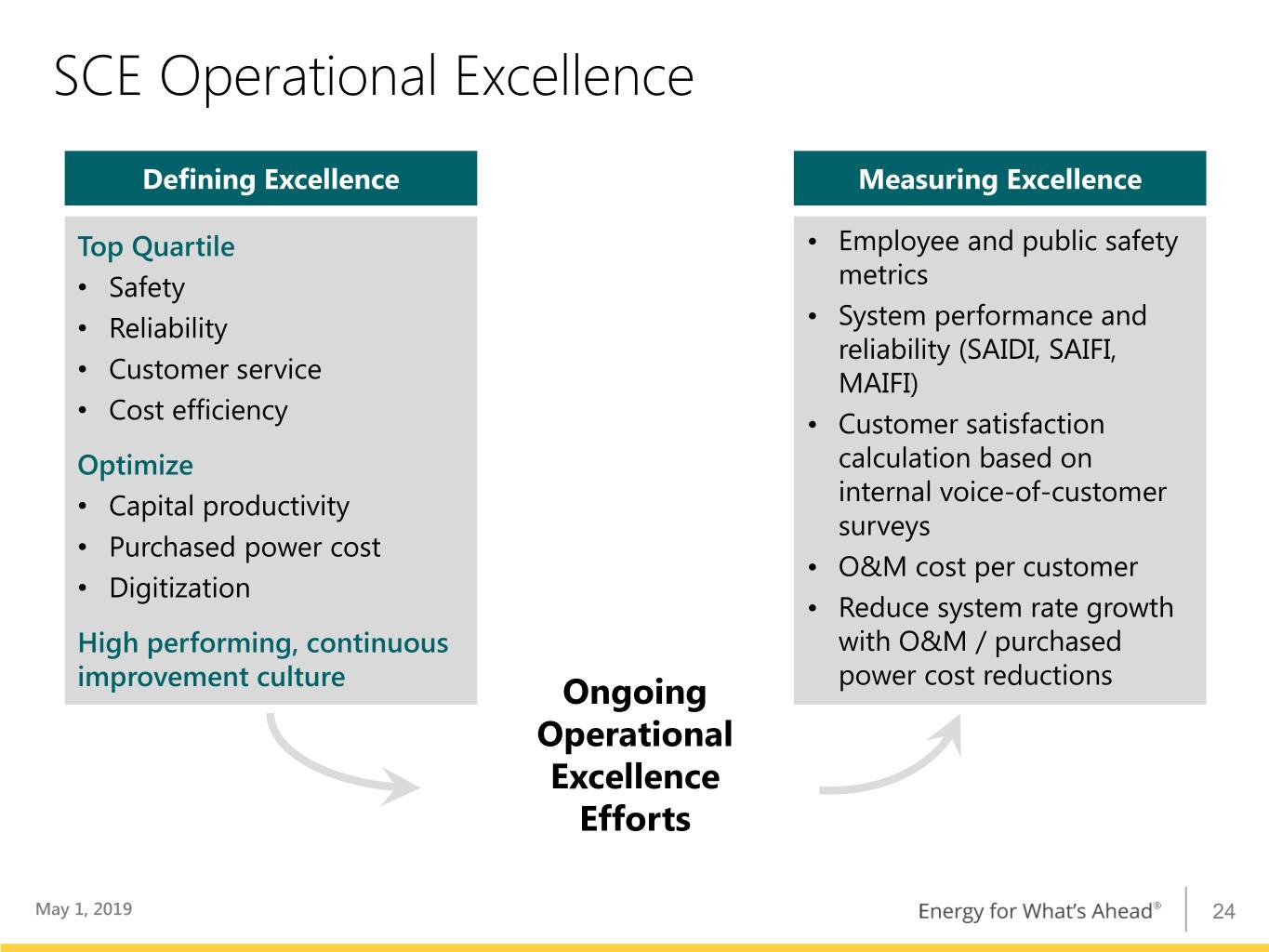
SCE Operational Excellence Defining Excellence Measuring Excellence Top Quartile • Employee and public safety • Safety metrics • Reliability • System performance and reliability (SAIDI, SAIFI, • Customer service MAIFI) • Cost efficiency • Customer satisfaction Optimize calculation based on internal voice-of-customer • Capital productivity surveys • Purchased power cost • O&M cost per customer • Digitization • Reduce system rate growth High performing, continuous with O&M / purchased improvement culture Ongoing power cost reductions Operational Excellence Efforts May 1, 2019 24
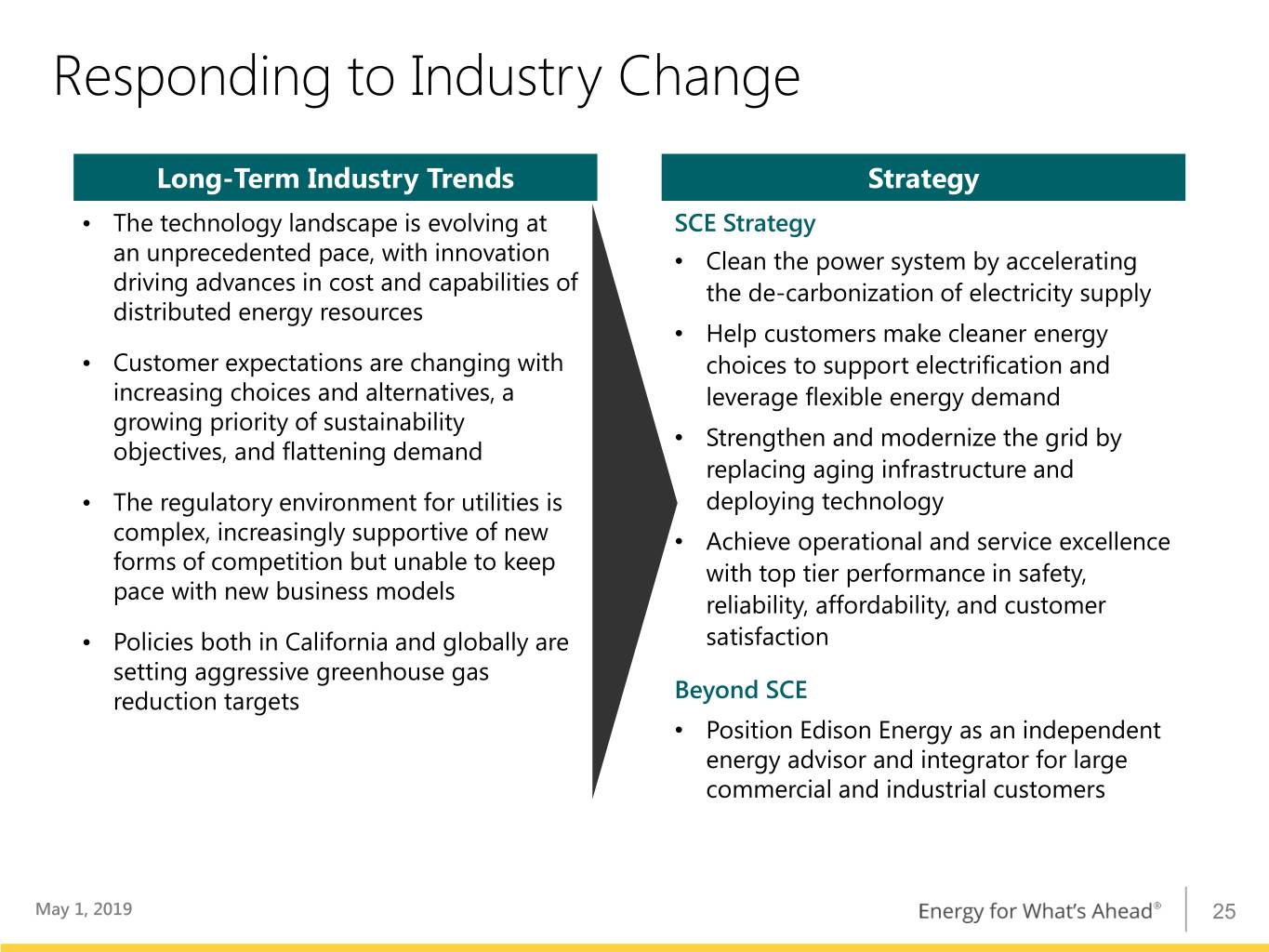
Responding to Industry Change Long-Term Industry Trends Strategy • The technology landscape is evolving at SCE Strategy an unprecedented pace, with innovation • Clean the power system by accelerating driving advances in cost and capabilities of the de-carbonization of electricity supply distributed energy resources • Help customers make cleaner energy • Customer expectations are changing with choices to support electrification and increasing choices and alternatives, a leverage flexible energy demand growing priority of sustainability • Strengthen and modernize the grid by objectives, and flattening demand replacing aging infrastructure and • The regulatory environment for utilities is deploying technology complex, increasingly supportive of new • Achieve operational and service excellence forms of competition but unable to keep with top tier performance in safety, pace with new business models reliability, affordability, and customer • Policies both in California and globally are satisfaction setting aggressive greenhouse gas reduction targets Beyond SCE • Position Edison Energy as an independent energy advisor and integrator for large commercial and industrial customers May 1, 2019 25
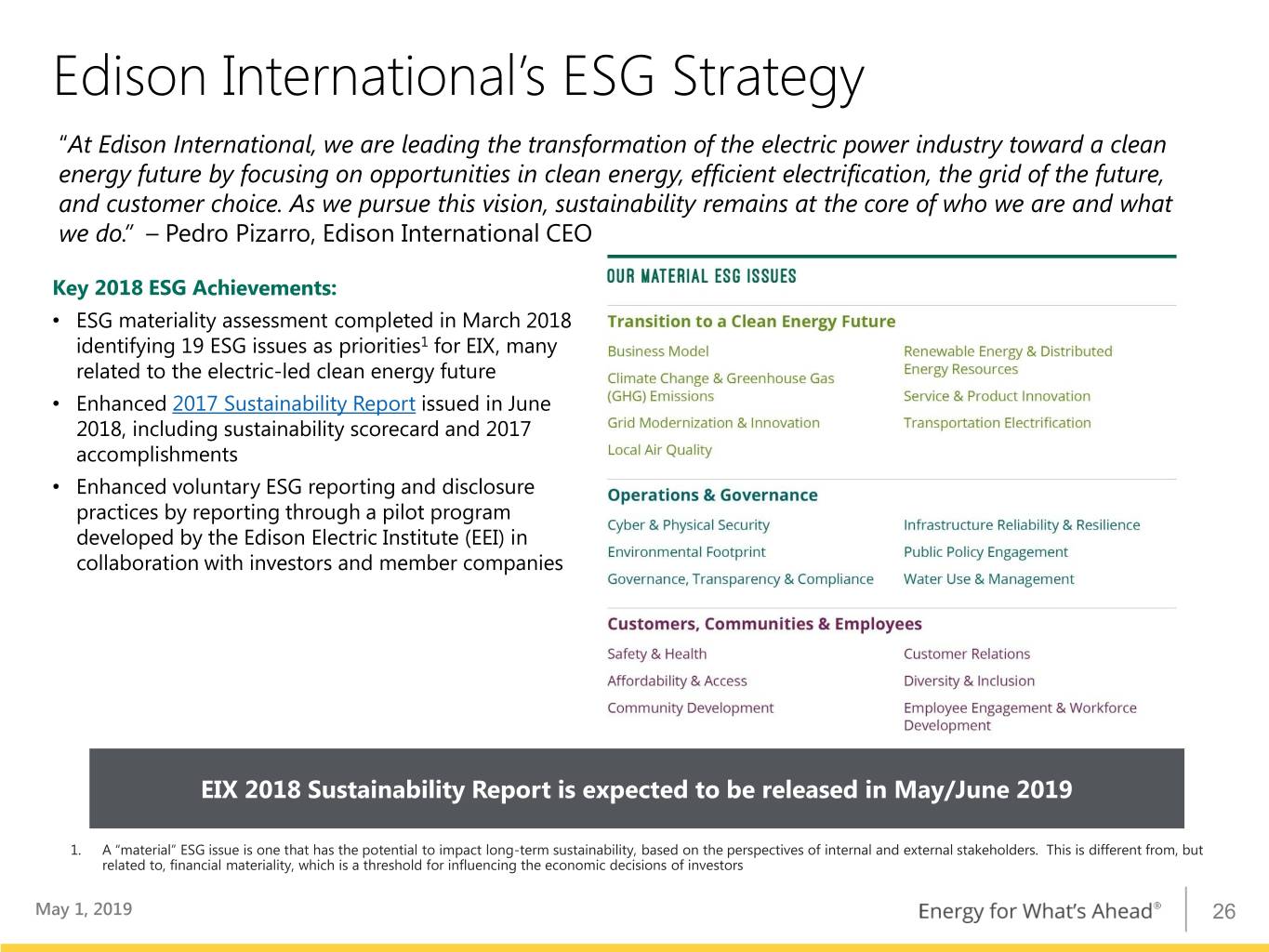
Edison International’s ESG Strategy “At Edison International, we are leading the transformation of the electric power industry toward a clean energy future by focusing on opportunities in clean energy, efficient electrification, the grid of the future, and customer choice. As we pursue this vision, sustainability remains at the core of who we are and what we do.” – Pedro Pizarro, Edison International CEO Key 2018 ESG Achievements: • ESG materiality assessment completed in March 2018 identifying 19 ESG issues as priorities1 for EIX, many related to the electric-led clean energy future • Enhanced 2017 Sustainability Report issued in June 2018, including sustainability scorecard and 2017 accomplishments • Enhanced voluntary ESG reporting and disclosure practices by reporting through a pilot program developed by the Edison Electric Institute (EEI) in collaboration with investors and member companies EIX 2018 Sustainability Report is expected to be released in May/June 2019 1. A “material” ESG issue is one that has the potential to impact long-term sustainability, based on the perspectives of internal and external stakeholders. This is different from, but related to, financial materiality, which is a threshold for influencing the economic decisions of investors May 1, 2019 26
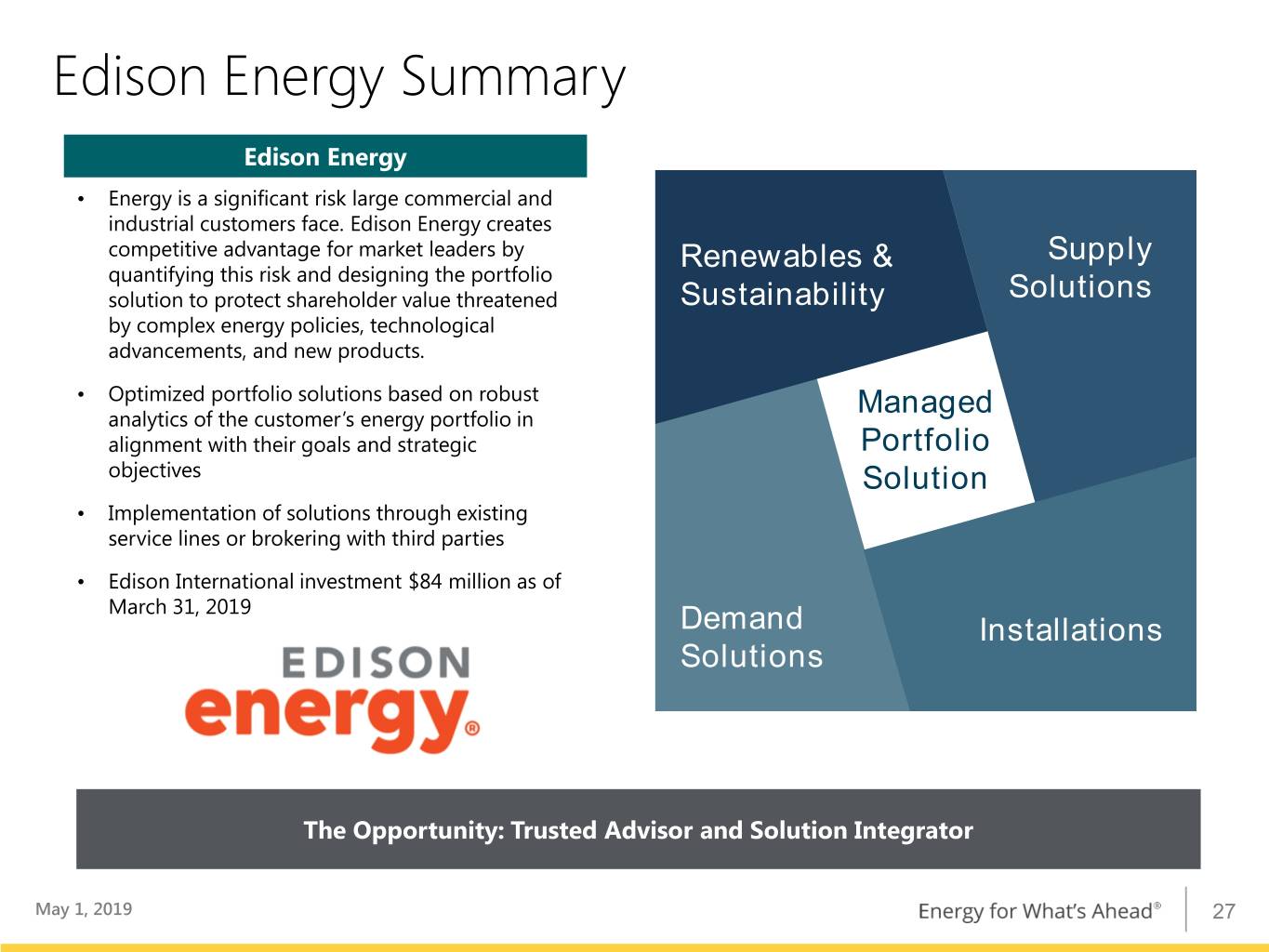
Edison Energy Summary Edison Energy • Energy is a significant risk large commercial and industrial customers face. Edison Energy creates competitive advantage for market leaders by Renewables & Supply quantifying this risk and designing the portfolio solution to protect shareholder value threatened Sustainability Solutions by complex energy policies, technological advancements, and new products. • Optimized portfolio solutions based on robust Managed analytics of the customer’s energy portfolio in alignment with their goals and strategic Portfolio objectives Solution • Implementation of solutions through existing service lines or brokering with third parties • Edison International investment $84 million as of March 31, 2019 Demand Installations Solutions The Opportunity: Trusted Advisor and Solution Integrator May 1, 2019 27
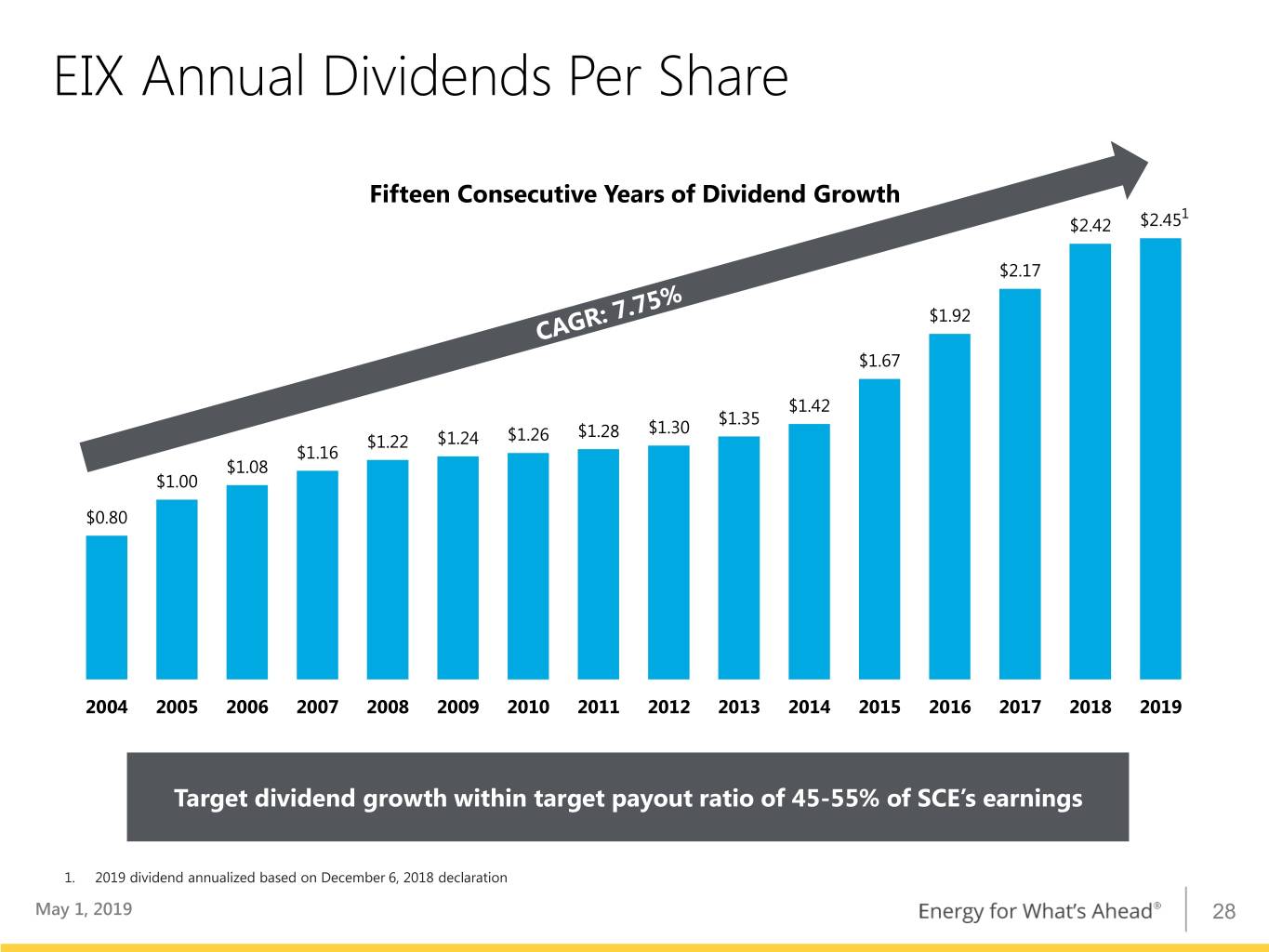
EIX Annual Dividends Per Share Fifteen Consecutive Years of Dividend Growth 1 $2.42 $2.45 $2.17 $1.92 $1.67 $1.42 $1.35 $1.28 $1.30 $1.22 $1.24 $1.26 $1.16 $1.08 $1.00 $0.80 2004 2005 2006 2007 2008 2009 2010 2011 2012 2013 2014 2015 2016 2017 2018 2019 Target dividend growth within target payout ratio of 45-55% of SCE’s earnings 1. 2019 dividend annualized based on December 6, 2018 declaration May 1, 2019 28
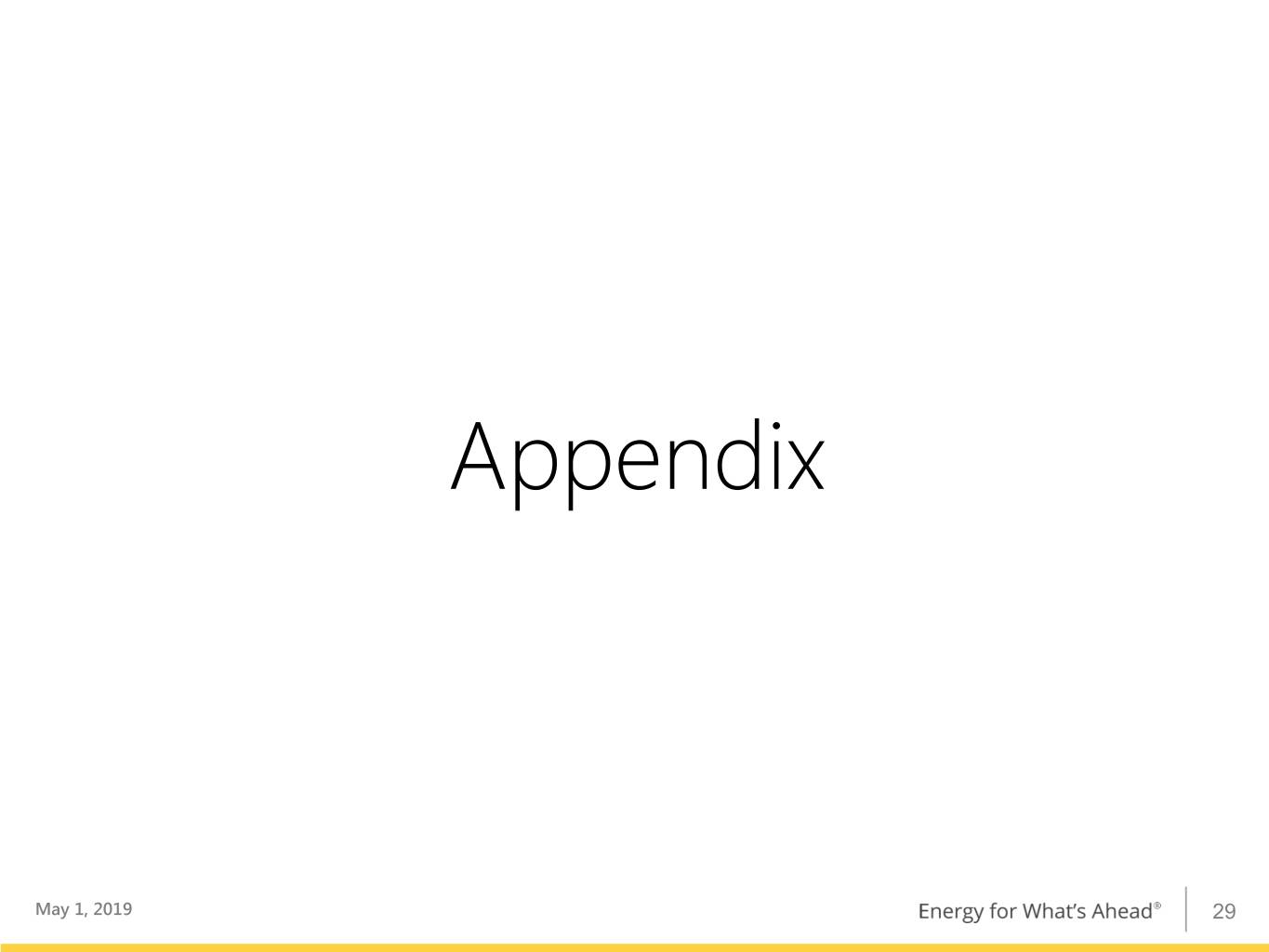
Appendix May 1, 2019 29
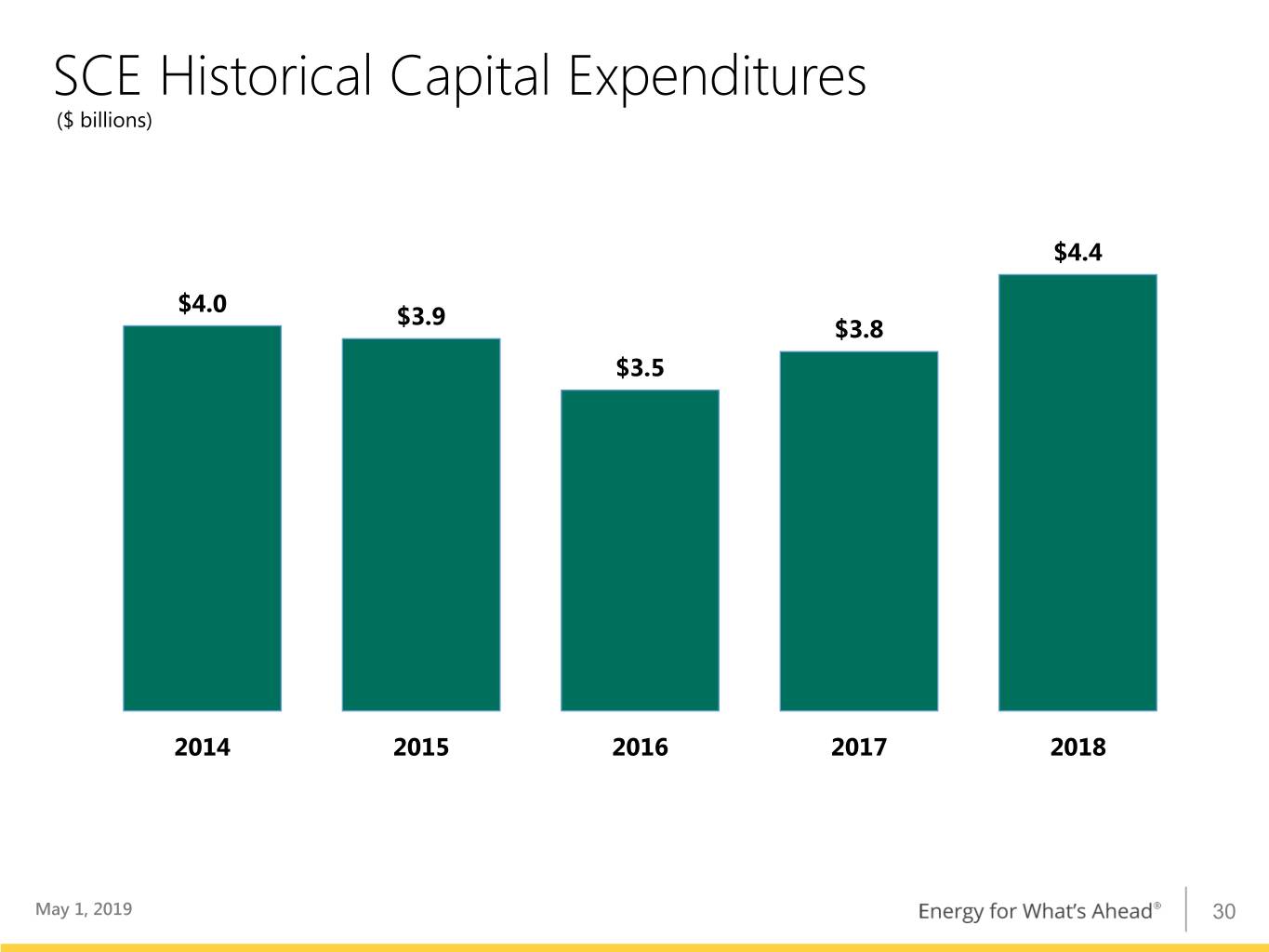
SCE Historical Capital Expenditures ($ billions) $4.4 $4.0 $3.9 $3.8 $3.5 2014 2015 2016 2017 2018 May 1, 2019 30

Capital Expenditure/Rate Base Detailed Forecast ($ in billions) Detailed Capital Expenditures – 2017-2020 2017 2018 2019 2020 Total (Actual) (Actual) (Plan) (PD) 2019-2020 Distribution1,2 $3.1 $3.5 $3.2 $2.9 $6.1 Transmission1 0.5 0.7 0.7 0.8 1.5 Generation1 0.2 0.2 0.2 0.2 0.4 Subtotal $3.8 $4.4 $4.1 $3.9 $8.0 Wildfire Mitigation-Related Spending - - 0.4 0.5-0.7 0.9-1.1 Total $3.8 $4.4 $4.5 $4.4-4.6 $8.9-9.1 Rate Base – 2017-2020 2017 2018 2019 2020 (Authorized) (PD) (PD) (PD) Rate Base3 $26.2 $28.4 $30.7 $33.1 1. Includes allocated capitalized overheads and general plant 2. Includes capital expenditures of approximately $54 million for wildfire-related spend in 2018 3. Does not include wildfire mitigation-related dollars Note: Totals may not foot due to rounding. May 1, 2019 31
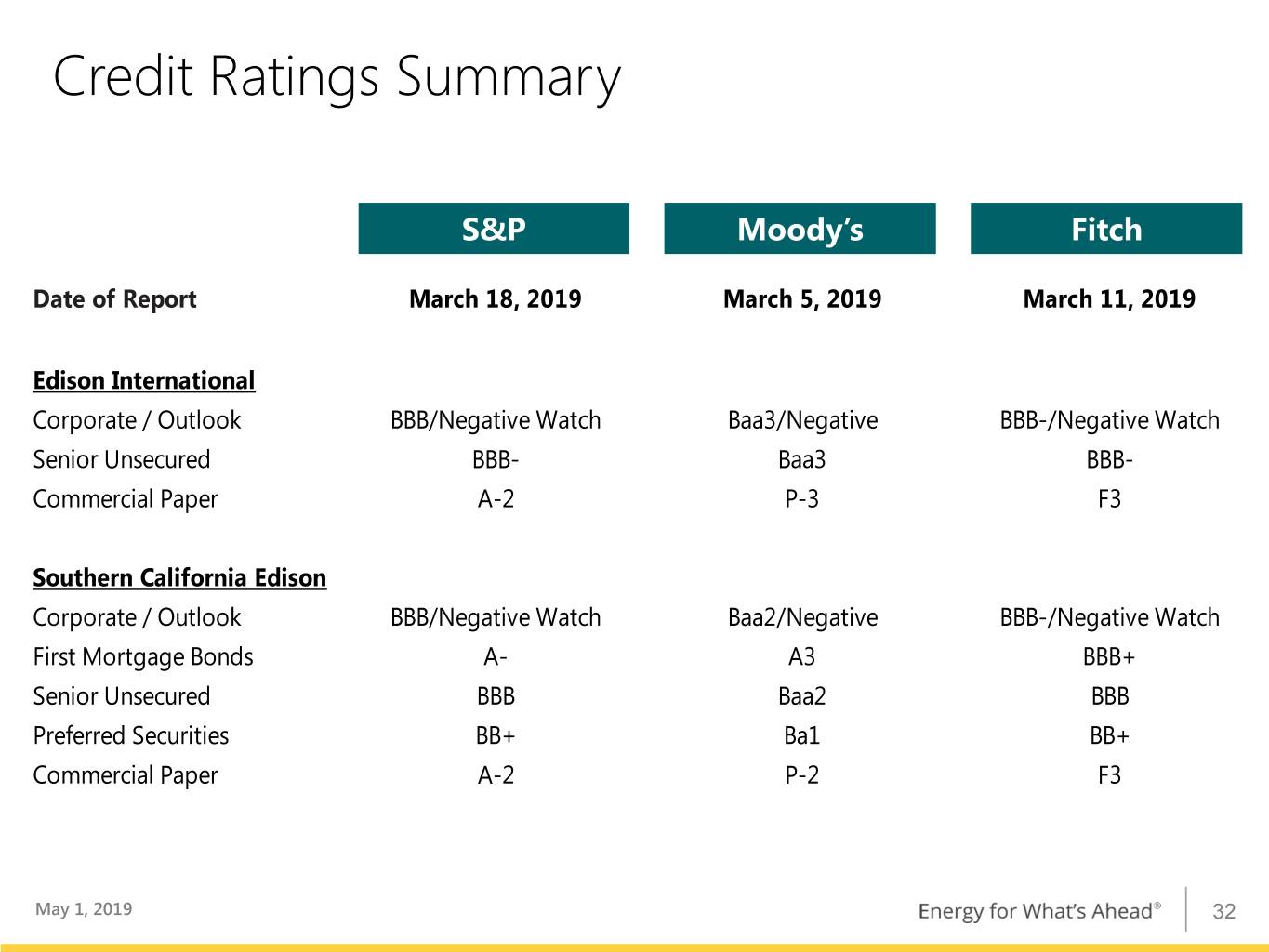
Credit Ratings Summary S&P Moody’s Fitch Date of Report March 18, 2019 March 5, 2019 March 11, 2019 Edison International Corporate / Outlook BBB/Negative Watch Baa3/Negative BBB-/Negative Watch Senior Unsecured BBB- Baa3 BBB- Commercial Paper A-2 P-3 F3 Southern California Edison Corporate / Outlook BBB/Negative Watch Baa2/Negative BBB-/Negative Watch First Mortgage Bonds A- A3 BBB+ Senior Unsecured BBB Baa2 BBB Preferred Securities BB+ Ba1 BB+ Commercial Paper A-2 P-2 F3 May 1, 2019 32

Distribution Power Grid of the Future Current State Future State One-Way Electricity Flow Variable, Two-Way Electricity Flow • System designed to distribute electricity • Distribution system at the center of the from large central generating plants power grid • Voltage centrally maintained • System designed to manage fluctuating • Increasing integration of distributed resources and customer demand energy resources • Digital monitoring and control devices and • Limited situational awareness and advanced communications systems to visualization tools for power grid improve safety and reliability, and integrate operators DERs • Improved data management and power Renewable Generation Mandates grid operations and cyber risk mitigation Subsidized Residential Solar • Integrated utility distribution with distributed energy resources planning Limited Electric Vehicle Charging Infrastructure Maximize Distributed Resources and Electric Vehicle Adoption • Distribution power grid infrastructure design supports customer choice and greater resiliency May 1, 2019 33

Grid Modernization Highlights Devices that provide Devices that provide stable voltage and power quality more flexibility during outage events Future circuit designs integrate State of the art Distributed operating tools Energy Resources for utility and increase operators and flexibility engineers Smart meters that provide information to facilitate The distribution customer reliability and system will require affordability transformative technologies in planning, design, construction and operation Net benefits to customers include increased safety, High speed wireless and reliability, access to Remote sensors that collect fiber communications affordable localized information about the grid infrastructure programs, and ability to adopt Legend new clean and distributed Remote Fault Indicator Computing intelligence inside technologies High speed bandwidth field area network electrical substations (communication system) Intelligent Remote Switches Centrally controlled switched capacitor bank w/ voltage control May 1, 2019 34

SCE Customer Demand Trends Kilowatt-Hour Sales (millions of kWh) 2014 2015 2016 2017 2018 Residential 30,027 30,093 29,579 30,221 29,865 Commercial 42,004 42,396 42,189 42,514 42,369 Industrial 8,392 7,623 7,162 6,659 6,786 Public authorities 4,975 4,795 4,715 4,711 4,510 Agricultural and other 2,019 1,950 1,803 1,498 1,745 Subtotal 87,416 86,857 85,448 85,602 85,276 Resale 1,308 1,080 1,794 1,568 1,867 Total Kilowatt-Hour Sales 88,725 87,937 87,242 87,170 87,143 Customers Residential 4,368,897 4,393,150 4,417,340 4,447,706 4,477,508 Commercial 557,957 561,475 565,222 569,222 572,313 Industrial 10,782 10,811 10,445 10,274 10,078 Public authorities 46,234 46,436 46,133 46,410 46,059 Agricultural 21,404 21,306 21,233 21,045 20,872 Railroads and railways 105 130 133 137 131 Interdepartmental 22 22 22 24 24 Total Number of Customers 5,005,401 5,033,330 5,060,528 5,094,818 5,126,985 Number of New Connections 29,879 31,653 38,076 39,621 39,633 Area Peak Demand (MW) 23,055 23,079 23,091 23,508 23,766 Note: See Edison International Financial and Statistical Reports for 2017 for further information. May 1, 2019 35

SCE Bundled Revenue Requirement 2019 Bundled Revenue Requirement $millions ¢/kWh Fuel & Purchased Power – includes CDWR Bond 4,869 7.0 Fuel & Purchased Power Charge (44%) Distribution – poles, wires, substations, service 4,362 6.2 centers; Edison SmartConnect® Distribution Generation – owned generation investment and O&M 837 1.2 (39%) Generation (8%) Transmission – greater than 220kV 939 1.4 Transmission (8%) Other – CPUC and legislative public purpose 87 0.1 Other (1%) programs, system reliability investments, nuclear decommissioning, and prior-year over collections Total Bundled Revenue Requirement ($millions) $11,094 Bundled kWh (millions) 69,856 = Bundled Systemwide Average Rate (¢/kWh) 15.9¢ SCE Systemwide Average Rate History (¢/kWh) 2010 2011 2012 2013 2014 2015 2016 2017 2018 2019 14.3 14.1 14.3 15.9 16.7 16.2 14.8 15.7 16.0 15.9 Note: Rates in effect as of January 1, 2019. Represents bundled service which excludes Direct Access/CCA customers that do not receive generation services from SCE. May 1, 2019 36
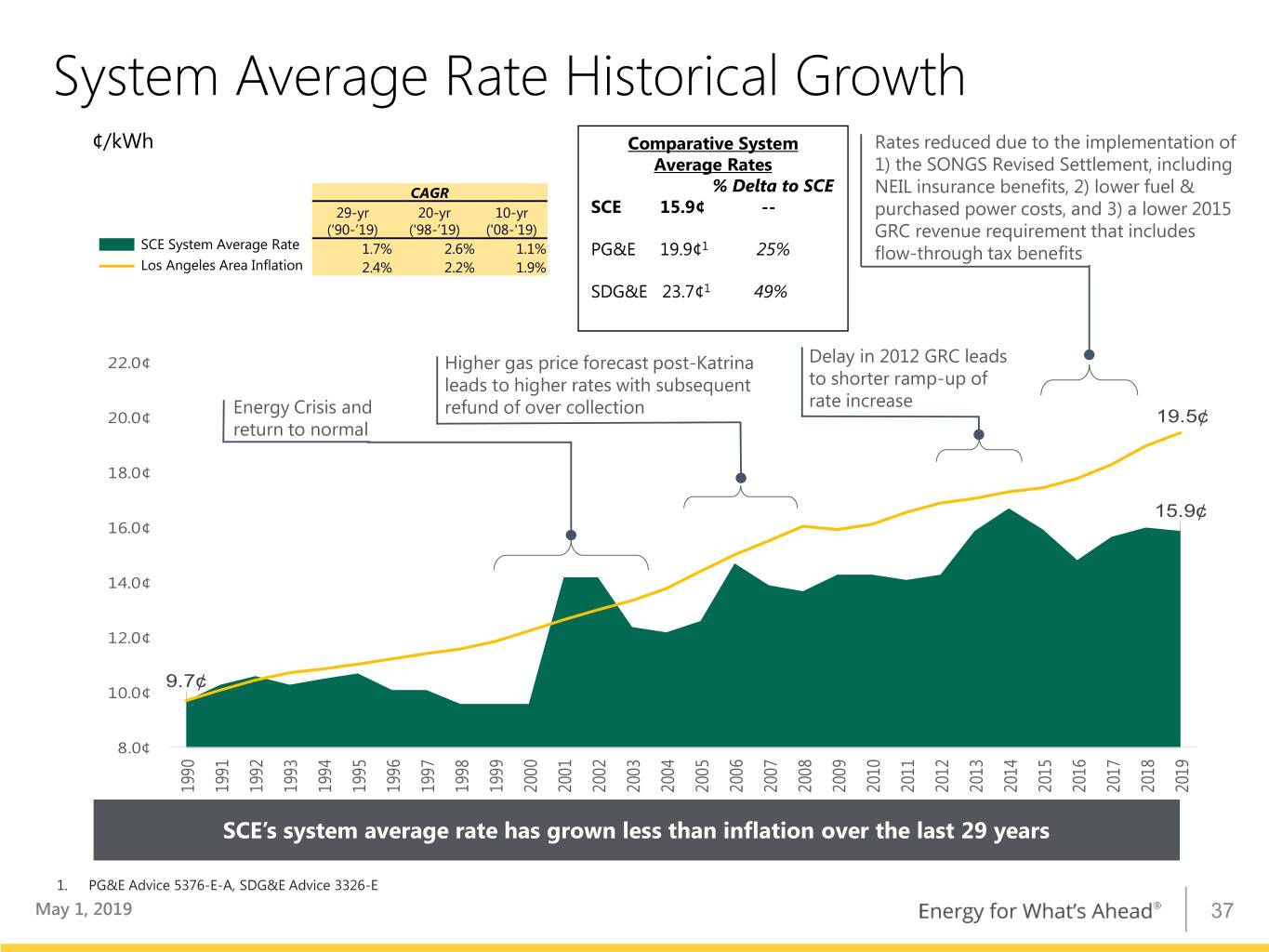
System Average Rate Historical Growth ¢/kWh Comparative System Rates reduced due to the implementation of Average Rates 1) the SONGS Revised Settlement, including CAGR % Delta to SCE NEIL insurance benefits, 2) lower fuel & 29-yr 20-yr 10-yr SCE 15.9¢ -- purchased power costs, and 3) a lower 2015 (‘90-’19) ('98-’19) ('08-'19) GRC revenue requirement that includes SCE System Average Rate 1.7% 2.6% 1.1% PG&E 19.9¢1 25% flow-through tax benefits Los Angeles Area Inflation 2.4% 2.2% 1.9% SDG&E 23.7¢1 49% 22.0¢ Higher gas price forecast post-Katrina Delay in 2012 GRC leads leads to higher rates with subsequent to shorter ramp-up of Energy Crisis and refund of over collection rate increase 20.0¢ 19.5¢ return to normal 18.0¢ 15.9¢ 16.0¢ 14.0¢ 12.0¢ 9.7¢ 10.0¢ 8.0¢ 1990 1991 1992 1993 1994 1995 1996 1997 1998 1999 2000 2001 2002 2003 2004 2005 2006 2007 2008 2009 2010 2011 2012 2013 2014 2015 2016 2017 2018 2019 SCE’s system average rate has grown less than inflation over the last 29 years 1. PG&E Advice 5376-E-A, SDG&E Advice 3326-E May 1, 2019 37
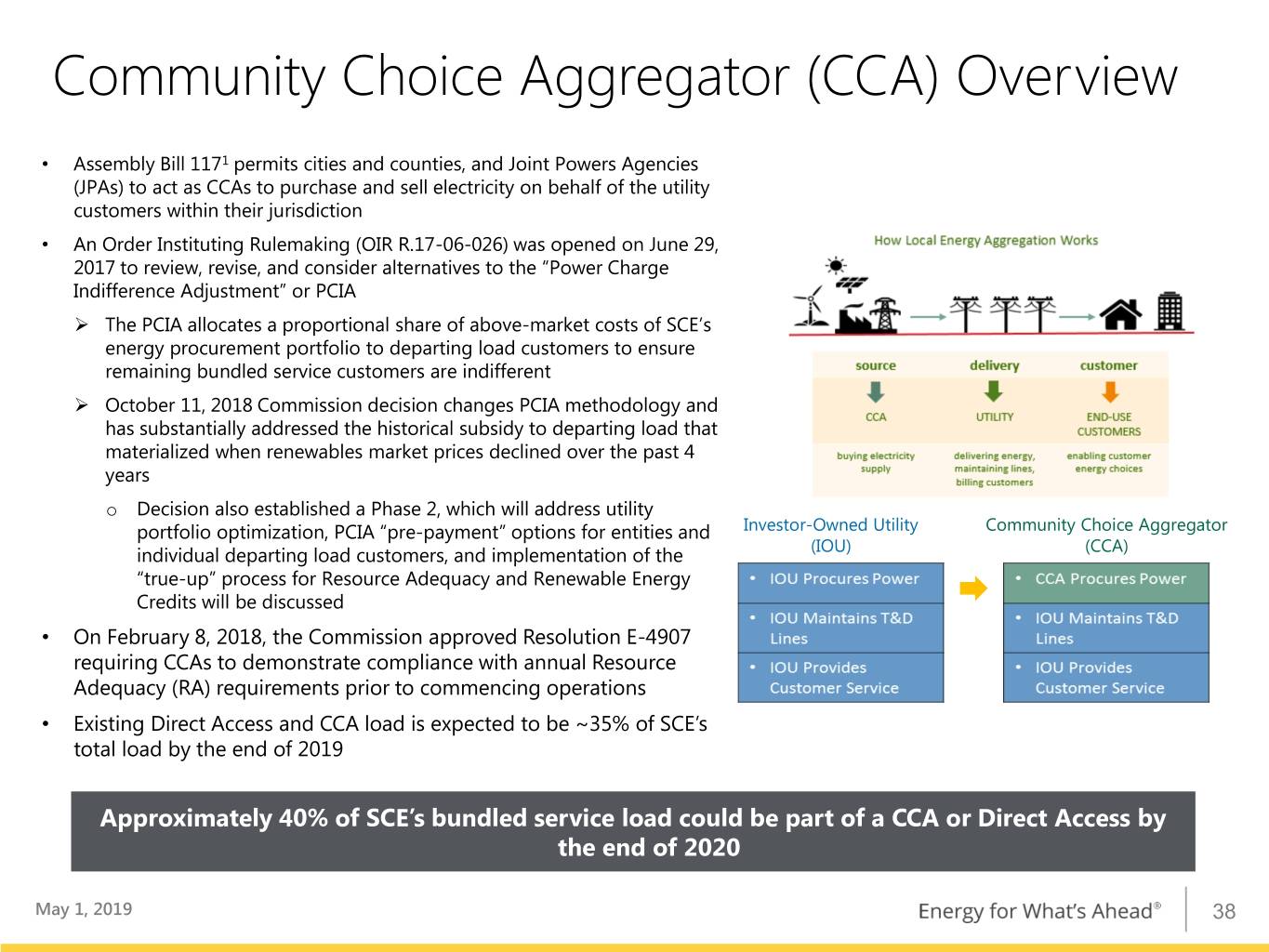
Community Choice Aggregator (CCA) Overview • Assembly Bill 1171 permits cities and counties, and Joint Powers Agencies (JPAs) to act as CCAs to purchase and sell electricity on behalf of the utility customers within their jurisdiction • An Order Instituting Rulemaking (OIR R.17-06-026) was opened on June 29, 2017 to review, revise, and consider alternatives to the “Power Charge Indifference Adjustment” or PCIA The PCIA allocates a proportional share of above-market costs of SCE’s energy procurement portfolio to departing load customers to ensure remaining bundled service customers are indifferent October 11, 2018 Commission decision changes PCIA methodology and has substantially addressed the historical subsidy to departing load that materialized when renewables market prices declined over the past 4 years o Decision also established a Phase 2, which will address utility portfolio optimization, PCIA “pre-payment” options for entities and Investor-Owned Utility Community Choice Aggregator individual departing load customers, and implementation of the (IOU) (CCA) “true-up” process for Resource Adequacy and Renewable Energy Credits will be discussed • On February 8, 2018, the Commission approved Resolution E-4907 requiring CCAs to demonstrate compliance with annual Resource Adequacy (RA) requirements prior to commencing operations • Existing Direct Access and CCA load is expected to be ~35% of SCE’s total load by the end of 2019 Approximately 40% of SCE’s bundled service load could be part of a CCA or Direct Access by the end of 2020 May 1, 2019 38
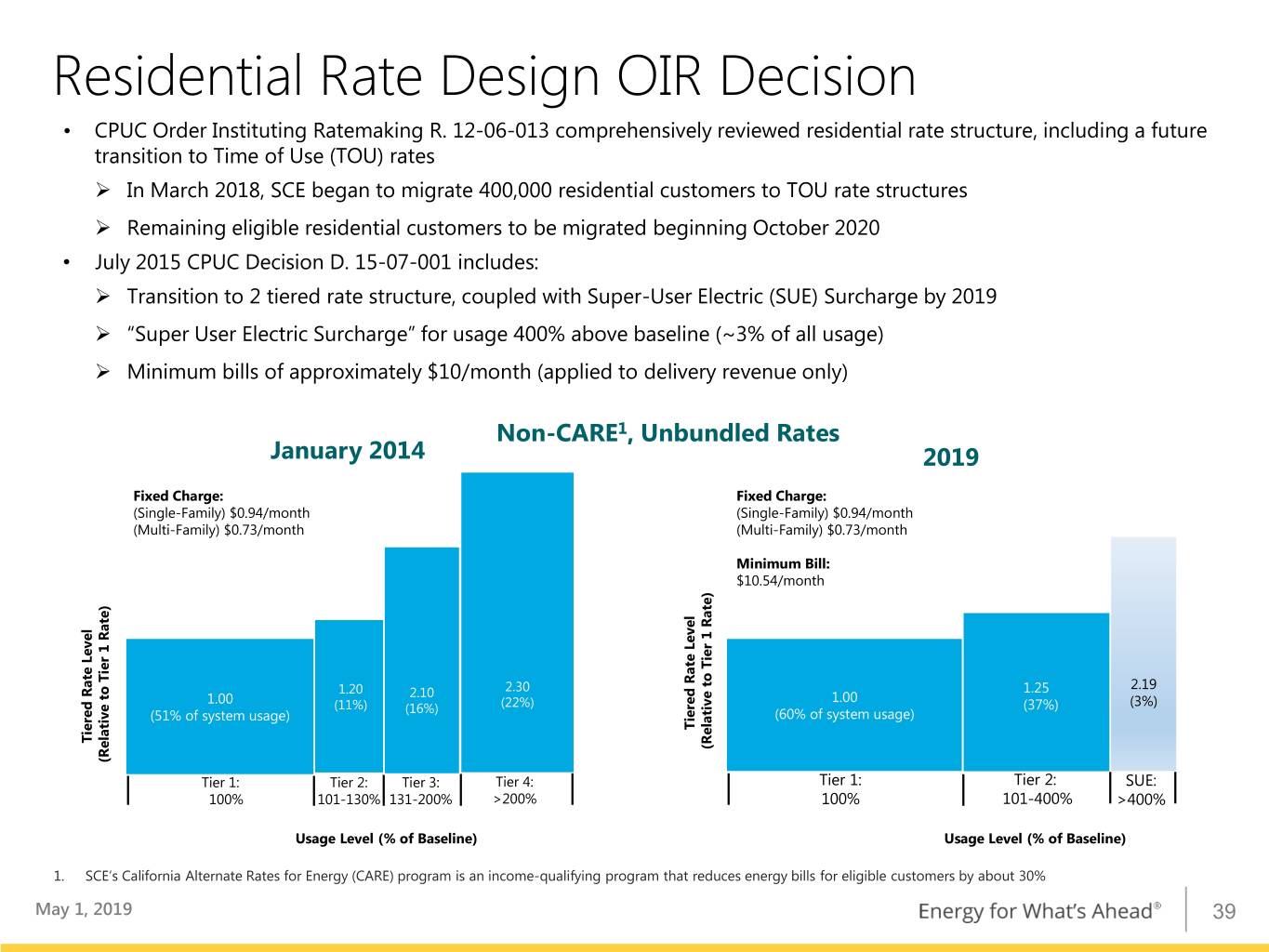
Residential Rate Design OIR Decision • CPUC Order Instituting Ratemaking R. 12-06-013 comprehensively reviewed residential rate structure, including a future transition to Time of Use (TOU) rates In March 2018, SCE began to migrate 400,000 residential customers to TOU rate structures Remaining eligible residential customers to be migrated beginning October 2020 • July 2015 CPUC Decision D. 15-07-001 includes: Transition to 2 tiered rate structure, coupled with Super-User Electric (SUE) Surcharge by 2019 “Super User Electric Surcharge” for usage 400% above baseline (~3% of all usage) Minimum bills of approximately $10/month (applied to delivery revenue only) Non-CARE1, Unbundled Rates January 2014 2019 Fixed Charge: Fixed Charge: (Single-Family) $0.94/month (Single-Family) $0.94/month (Multi-Family) $0.73/month (Multi-Family) $0.73/month Minimum Bill: $10.54/month 2.19 1.20 2.10 2.30 1.25 1.00 1.00 (3%) (11%) (16%) (22%) (37%) (51% of system usage) (60% of system usage) Tiered Rate Level Level Tiered Rate Tiered Rate Level Level Tiered Rate (Relative to Tier Tier Rate) 1 to (Relative (Relative to Tier Tier Rate) 1 to (Relative Tier 1: Tier 2: Tier 3: Tier 4: Tier 1: Tier 2: SUE: 100% 101-130% 131-200% >200% 100% 101-400% >400% Usage Level (% of Baseline) Usage Level (% of Baseline) 1. SCE’s California Alternate Rates for Energy (CARE) program is an income-qualifying program that reduces energy bills for eligible customers by about 30% May 1, 2019 39
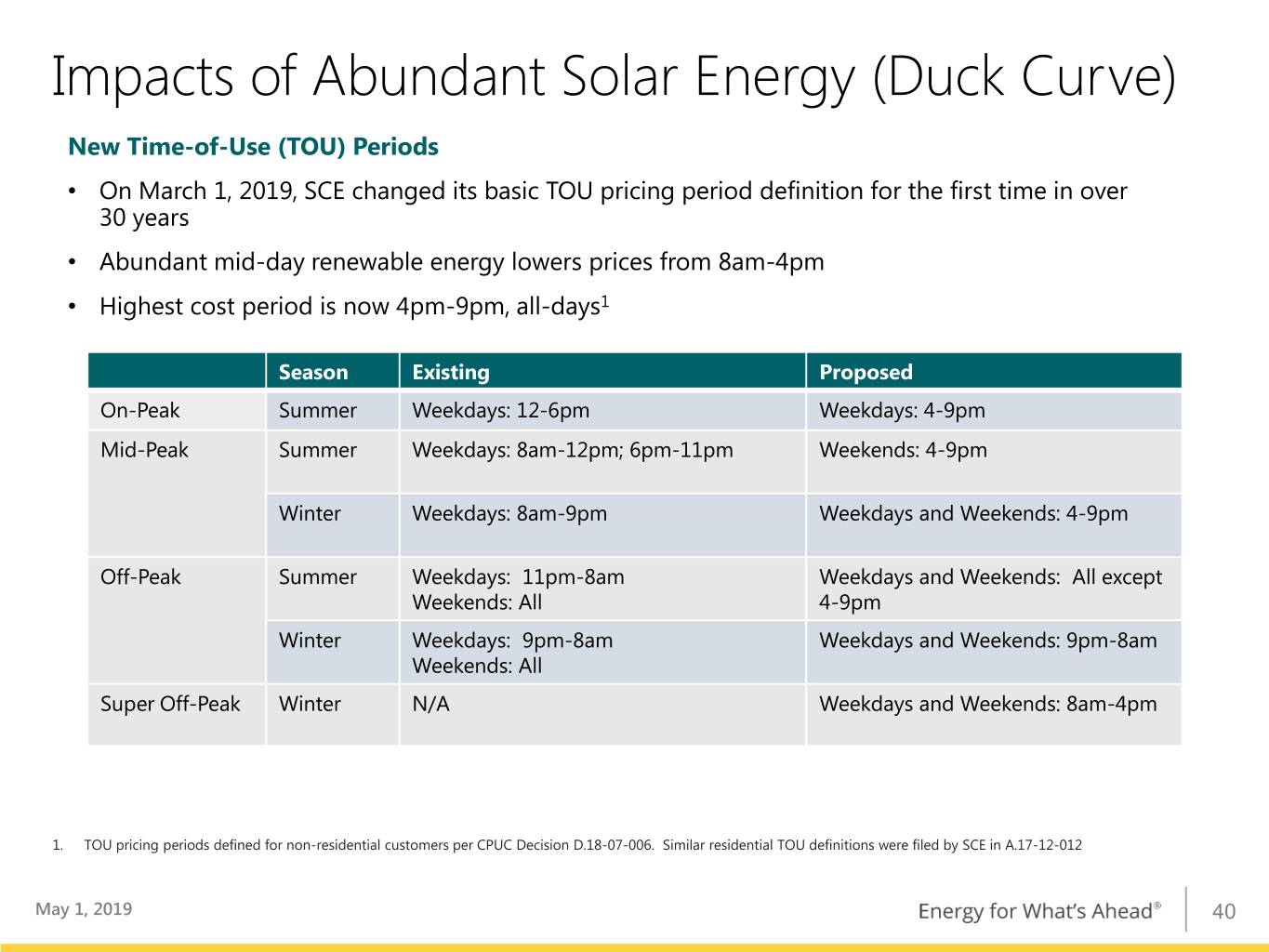
Impacts of Abundant Solar Energy (Duck Curve) New Time-of-Use (TOU) Periods • On March 1, 2019, SCE changed its basic TOU pricing period definition for the first time in over 30 years • Abundant mid-day renewable energy lowers prices from 8am-4pm • Highest cost period is now 4pm-9pm, all-days1 Season Existing Proposed On-Peak Summer Weekdays: 12-6pm Weekdays: 4-9pm Mid-Peak Summer Weekdays: 8am-12pm; 6pm-11pm Weekends: 4-9pm Winter Weekdays: 8am-9pm Weekdays and Weekends: 4-9pm Off-Peak Summer Weekdays: 11pm-8am Weekdays and Weekends: All except Weekends: All 4-9pm Winter Weekdays: 9pm-8am Weekdays and Weekends: 9pm-8am Weekends: All Super Off-Peak Winter N/A Weekdays and Weekends: 8am-4pm 1. TOU pricing periods defined for non-residential customers per CPUC Decision D.18-07-006. Similar residential TOU definitions were filed by SCE in A.17-12-012 May 1, 2019 40
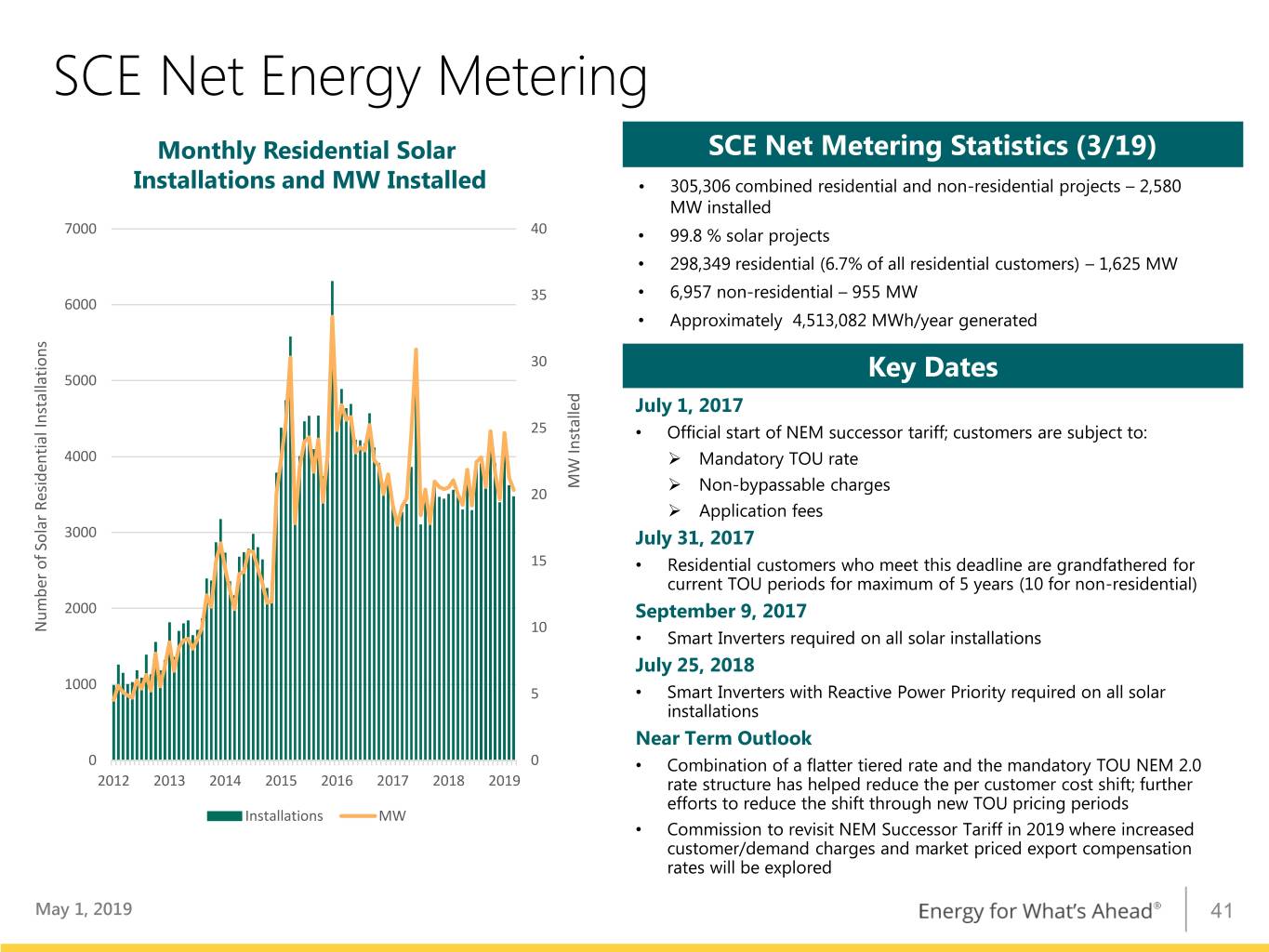
SCE Net Energy Metering Monthly Residential Solar SCE Net Metering Statistics (3/19) Installations and MW Installed • 305,306 combined residential and non-residential projects – 2,580 MW installed 7000 40 • 99.8 % solar projects • 298,349 residential (6.7% of all residential customers) – 1,625 MW 35 • 6,957 non-residential – 955 MW 6000 • Approximately 4,513,082 MWh/year generated 30 5000 Key Dates July 1, 2017 25 • Official start of NEM successor tariff; customers are subject to: 4000 Mandatory TOU rate MW MW Installed Non-bypassable charges 20 Application fees 3000 July 31, 2017 15 • Residential customers who meet this deadline are grandfathered for current TOU periods for maximum of 5 years (10 for non-residential) 2000 September 9, 2017 NumberSolar of Residential Installations 10 • Smart Inverters required on all solar installations July 25, 2018 1000 5 • Smart Inverters with Reactive Power Priority required on all solar installations Near Term Outlook 0 0 • Combination of a flatter tiered rate and the mandatory TOU NEM 2.0 2012 2013 2014 2015 2016 2017 2018 2019 rate structure has helped reduce the per customer cost shift; further efforts to reduce the shift through new TOU pricing periods Installations MW • Commission to revisit NEM Successor Tariff in 2019 where increased customer/demand charges and market priced export compensation rates will be explored May 1, 2019 41
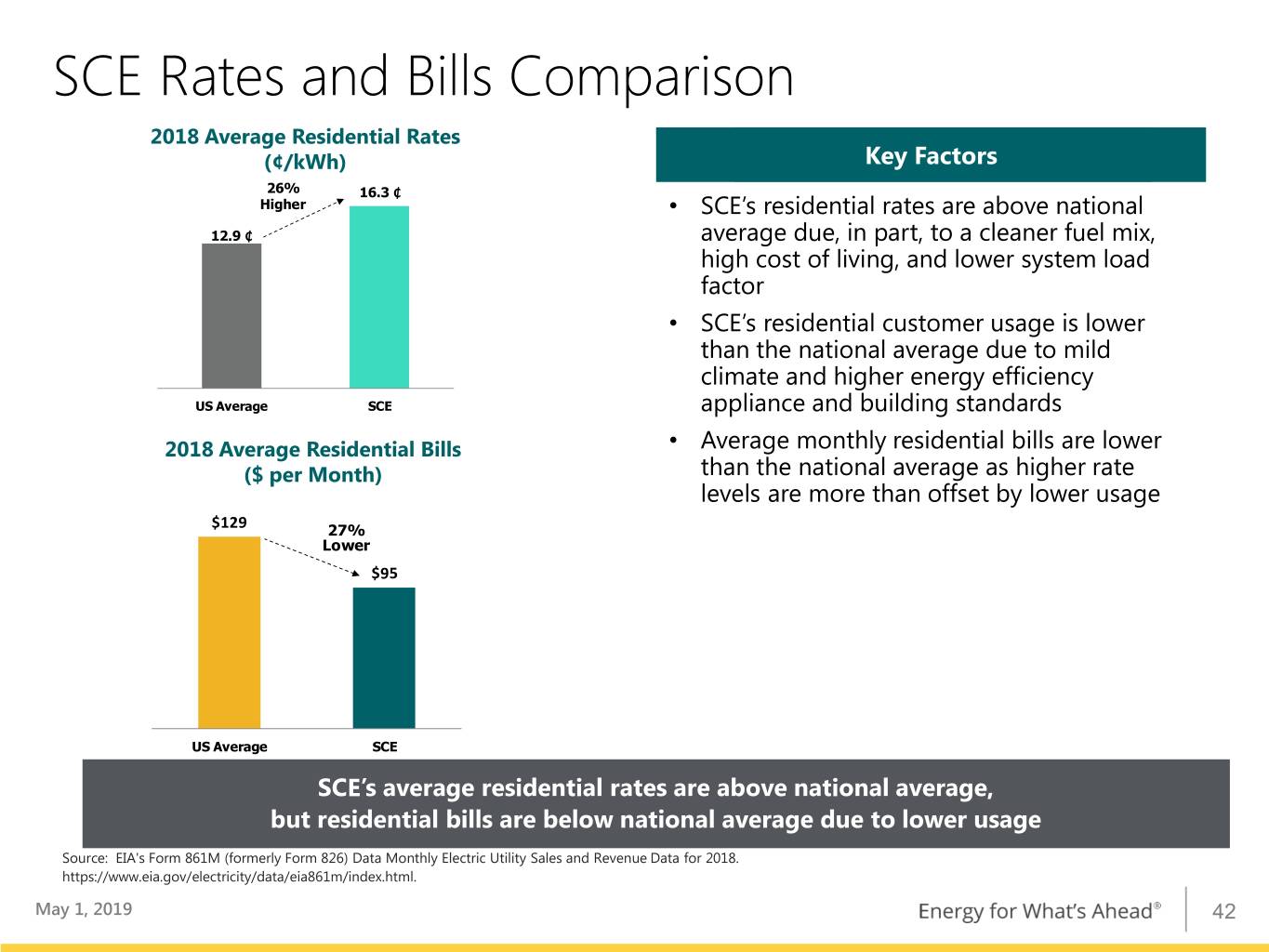
SCE Rates and Bills Comparison 2018 Average Residential Rates (¢/kWh) KeyKey Factors Factors 26% 16.3 ₵ Higher • SCE’s residential rates are above national 12.9 ₵ average due, in part, to a cleaner fuel mix, high cost of living, and lower system load factor • SCE’s residential customer usage is lower than the national average due to mild climate and higher energy efficiency US Average SCE appliance and building standards 2018 Average Residential Bills • Average monthly residential bills are lower ($ per Month) than the national average as higher rate levels are more than offset by lower usage $129 27% Lower $95 US Average SCE SCE’s average residential rates are above national average, but residential bills are below national average due to lower usage Source: EIA's Form 861M (formerly Form 826) Data Monthly Electric Utility Sales and Revenue Data for 2018. https://www.eia.gov/electricity/data/eia861m/index.html. May 1, 2019 42
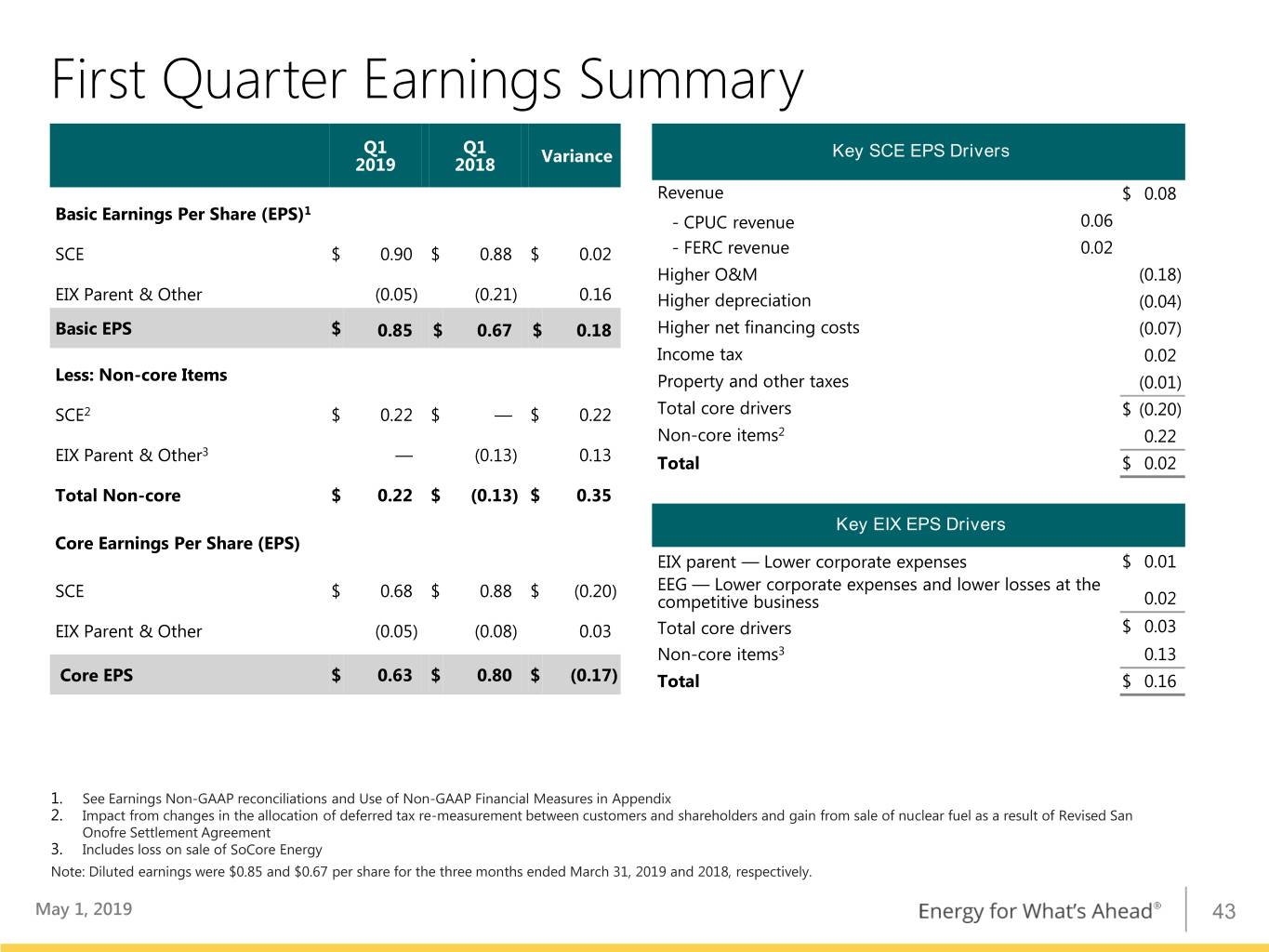
First Quarter Earnings Summary Q1 Q1 Key SCE EPS Drivers 2019 2018 Variance Revenue $ 0.08 1 Basic Earnings Per Share (EPS) - CPUC revenue 0.06 SCE $ 0.90 $ 0.88 $ 0.02 - FERC revenue 0.02 Higher O&M (0.18) EIX Parent & Other (0.05) (0.21) 0.16 Higher depreciation (0.04) Basic EPS $ 0.85 $ 0.67 $ 0.18 Higher net financing costs (0.07) Income tax 0.02 Less: Non-core Items Property and other taxes (0.01) SCE2 $ 0.22 $ — $ 0.22 Total core drivers $ (0.20) Non-core items2 0.22 3 EIX Parent & Other — (0.13) 0.13 Total $ 0.02 Total Non-core $ 0.22 $ (0.13) $ 0.35 Key EIX EPS Drivers Core Earnings Per Share (EPS) EIX parent — Lower corporate expenses $ 0.01 SCE $ 0.68 $ 0.88 $ (0.20) EEG — Lower corporate expenses and lower losses at the competitive business 0.02 EIX Parent & Other (0.05) (0.08) 0.03 Total core drivers $ 0.03 Non-core items3 0.13 Core EPS $ 0.63 $ 0.80 $ (0.17) Total $ 0.16 1. See Earnings Non-GAAP reconciliations and Use of Non-GAAP Financial Measures in Appendix 2. Impact from changes in the allocation of deferred tax re-measurement between customers and shareholders and gain from sale of nuclear fuel as a result of Revised San Onofre Settlement Agreement 3. Includes loss on sale of SoCore Energy Note: Diluted earnings were $0.85 and $0.67 per share for the three months ended March 31, 2019 and 2018, respectively. May 1, 2019 43
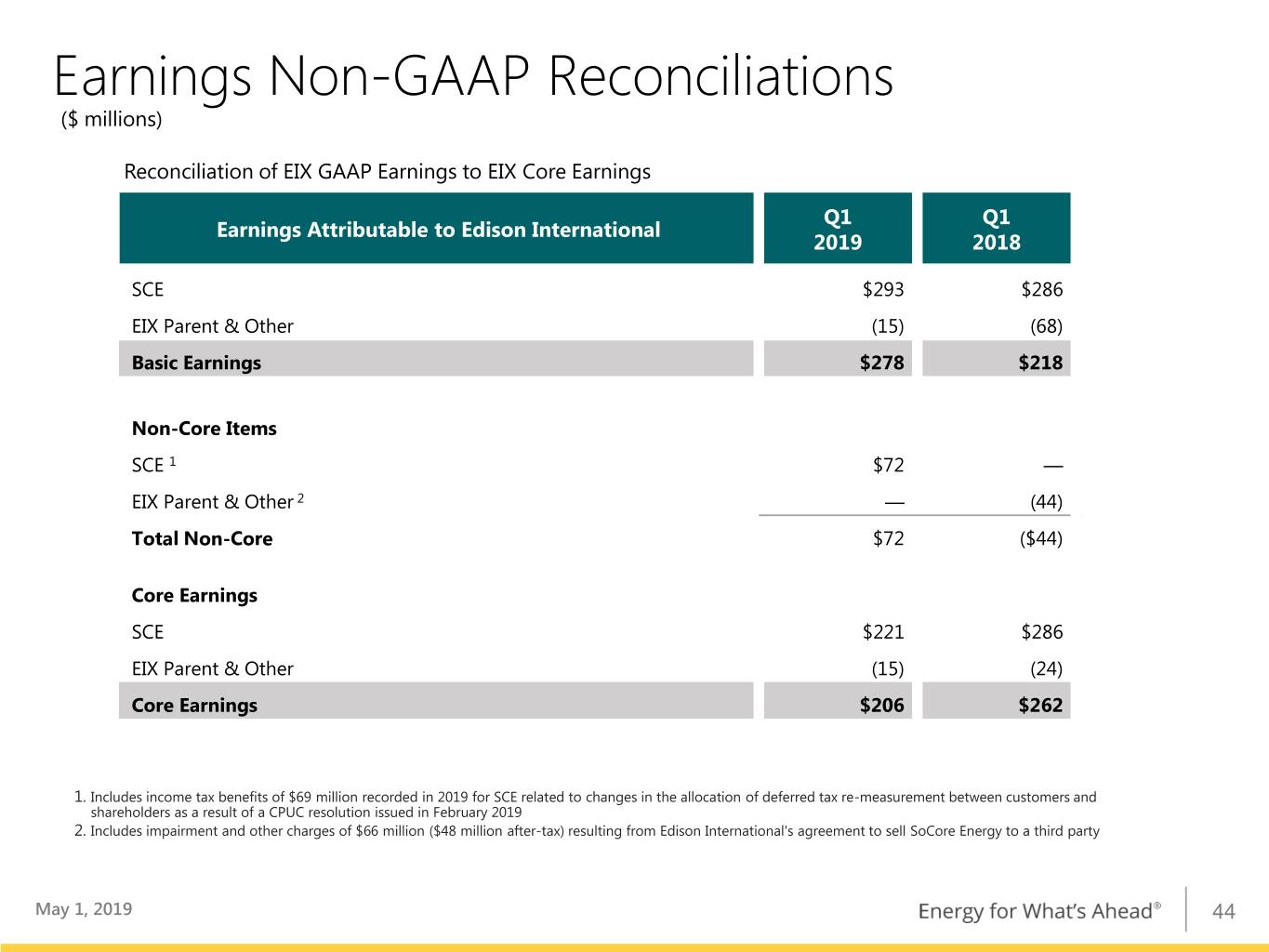
Earnings Non-GAAP Reconciliations ($ millions) Reconciliation of EIX GAAP Earnings to EIX Core Earnings Q1 Q1 Earnings Attributable to Edison International 2019 2018 SCE $293 $286 EIX Parent & Other (15) (68) Basic Earnings $278 $218 Non-Core Items SCE 1 $72 — EIX Parent & Other 2 — (44) Total Non-Core $72 ($44) Core Earnings SCE $221 $286 EIX Parent & Other (15) (24) Core Earnings $206 $262 1. Includes income tax benefits of $69 million recorded in 2019 for SCE related to changes in the allocation of deferred tax re-measurement between customers and shareholders as a result of a CPUC resolution issued in February 2019 2. Includes impairment and other charges of $66 million ($48 million after-tax) resulting from Edison International's agreement to sell SoCore Energy to a third party May 1, 2019 44

SCE Annual Results of Operations ($ millions) • Earning activities – revenue authorized by CPUC and FERC to provide reasonable cost recovery and return on investment • Cost-recovery activities – CPUC- and FERC-authorized balancing accounts to recover specific project or program costs, subject to reasonableness review or compliance with upfront standards 2018 2017 Earnings Cost-Recovery Total Earnings Cost-Recovery Total Activities Activities Consolidated Activities Activities Consolidated Operating revenue $6,560 $6,051 $12,611 $6,611 $5,643 $12,254 Purchased power and fuel — 5,406 5,406 — 4,873 4,873 Operation and maintenance 1,972 730 2,702 1,898 824 2,722 Wildfire-related claims, net of recoveries 2,669 — 2,669 ― ― ― Depreciation and amortization 1,867 — 1,867 2,032 — 2,032 Property and other taxes 392 — 392 372 — 372 Impairment and other charges (12) — (12) 716 — 716 Other operating income (7) — (7) (8) — (8) Total operating expenses 6,881 6,136 13,017 5,010 5,697 10,707 Operating (loss) income (321) (85) (406) 1,601 (54) 1,547 Interest expense (671) (2) (673) (588) (1) (589) Other income and expenses 107 87 194 93 55 148 (Loss) income before income taxes (885) — (885) 1,106 — 1,106 Income tax (benefit) expense (696) — (696) (30) — (30) Net (loss) income (189) — (189) 1,136 — 1,136 Preferred and preference stock dividend 121 — 121 124 — 124 requirements Net (loss) income available for common stock ($310) — ($310) $1,012 — $1,012 Less: Non-core items (1,750) (481) Core Earnings $1,440 $1,493 Note: See Use of Non-GAAP Financial Measures. May 1, 2019 45

EIX Core EPS Non-GAAP Reconciliations Reconciliation of Edison International Basic Earnings Per Share to Edison International Core Earnings Per Share Earnings Per Share Attributable to Edison International 2018 2017 Basic EPS ($1.30) $1.73 Non-Core Items SCE Wildfire-related claims, net of recoveries (5.60) — Settlement of 1994 – 2006 California tax audits 0.20 — Write down, impairment and other as a result of Revised San 0.03 (1.38) Onofre Settlement Agreement Re-measurement of deferred taxes as a result of Tax Reform — (0.10) Edison International Parent and Other Settlement of 1994 – 2006 California tax audits (0.04) — Re-measurement of deferred taxes as a result of Tax Reform — (1.33) Sale of SoCore Energy and other (0.14) 0.04 Discontinued operations Settlement of 1994 – 2006 California tax audits 0.10 — Less: Total Non-Core Items (5.45) (2.77) Core EPS $4.15 $4.50 Note: See Use of Non-GAAP Financial Measures. May 1, 2019 46
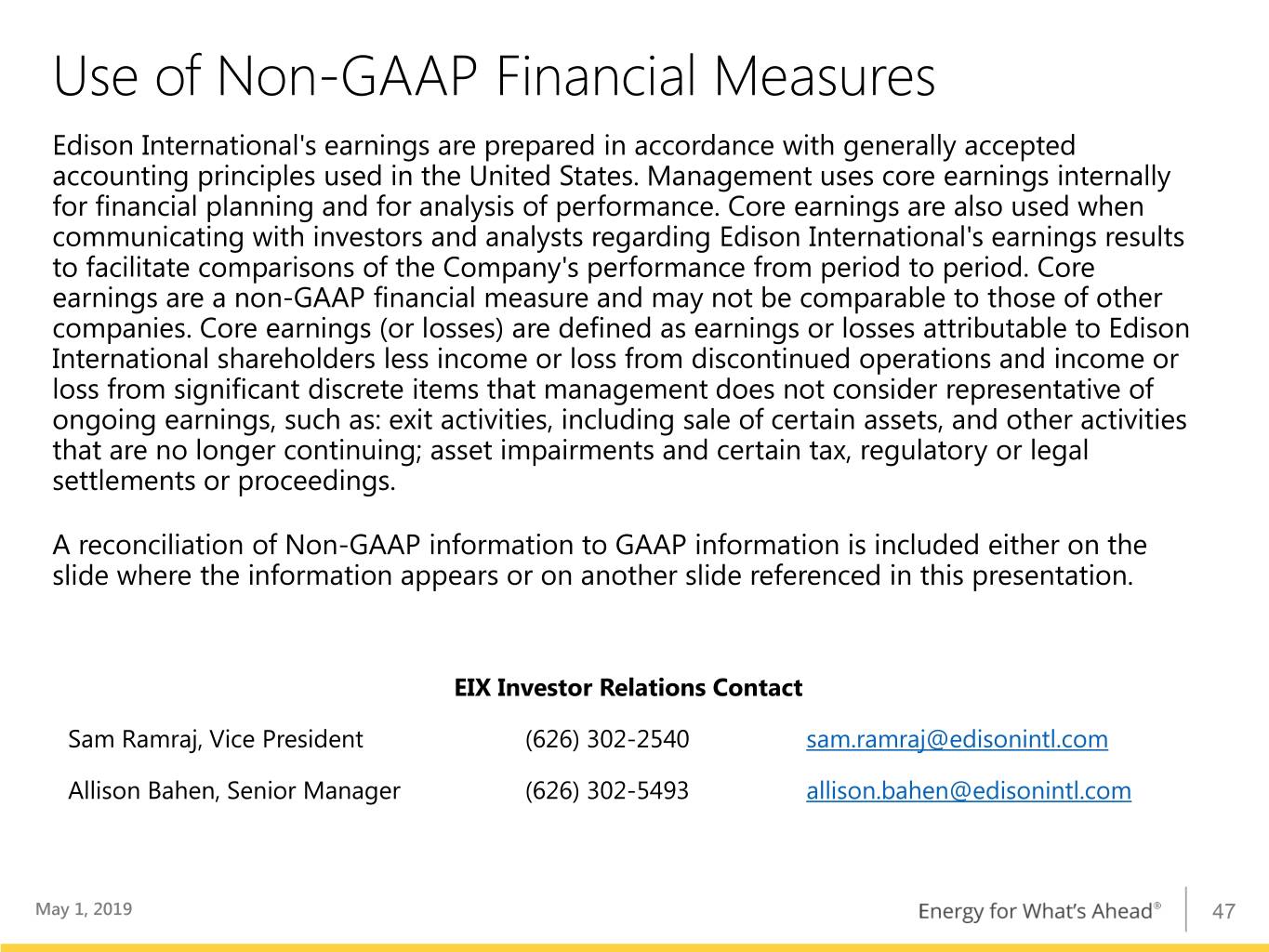
Use of Non-GAAP Financial Measures Edison International's earnings are prepared in accordance with generally accepted accounting principles used in the United States. Management uses core earnings internally for financial planning and for analysis of performance. Core earnings are also used when communicating with investors and analysts regarding Edison International's earnings results to facilitate comparisons of the Company's performance from period to period. Core earnings are a non-GAAP financial measure and may not be comparable to those of other companies. Core earnings (or losses) are defined as earnings or losses attributable to Edison International shareholders less income or loss from discontinued operations and income or loss from significant discrete items that management does not consider representative of ongoing earnings, such as: exit activities, including sale of certain assets, and other activities that are no longer continuing; asset impairments and certain tax, regulatory or legal settlements or proceedings. A reconciliation of Non-GAAP information to GAAP information is included either on the slide where the information appears or on another slide referenced in this presentation. EIX Investor Relations Contact Sam Ramraj, Vice President (626) 302-2540 sam.ramraj@edisonintl.com Allison Bahen, Senior Manager (626) 302-5493 allison.bahen@edisonintl.com May 1, 2019 47















































